Sound & Energy
Journeys, Events &
Sacred Instruments
Shop By Categories
✨ Explore Our Curated Sound & Energy Products ✨
From the enchanting aroma of essential oils that soothe your spirit to mesmerising crystals that amplify your energy, our collection is thoughtfully curated for both seasoned practitioners and curious newcomers alike. Explore our extensive range of crystals singing bowls and sacred sound instruments, to kickstart your journey with sound.
Browse Sacred Sound Journeys
✨ Explore Our Unique Sound & Energy Workshops & Classes ✨
🌟 Ready to transform your life and boost your personal development journey with the power of sound? 🎶
Book your ‘Sacred Sound Journey’ today, and awaken your path to discover and reach your highest potential!
Whether online or in-person, let's connect-create with the perfect sound immersion to
restore harmony and balance for your body-mind-soul-spirit.
Events | Group & Private Sessions | On-Line and In-Person
Explore our Sacred Sounds School
✨ Explore Our Unique Sound & Energy Workshops & Classes ✨
We offer a wide range of personal, soul and spiritual development workshops to accelerate your understanding
of chakras, energy, reiki, pendulum dowsing, spiritual practices, psychic development, mediumship,
astrology and channeling | You can also explore our unique Crystal singing bowl workshops and classes to
learn how to embrace the frequency of Sound, Colour and Light.
Group & Private Lessons | On-Line and In-Person
A Modern Journey to Understanding your Energy
Understanding your chakras and their attributes is important for maintaining balance and harmony in your physical, emotional, and spiritual well-being. Each chakra is associated with a specific area of the body and is linked to different emotions, behaviours, and mental states. By understanding the function and significance of each chakra, you can identify areas that need attention and work towards achieving optimal health and balance. Regularly practicing chakra-balancing exercises such as meditation, yoga, or energy healing can help improve your overall well-being and enhance your ability to handle stress and challenges in life.
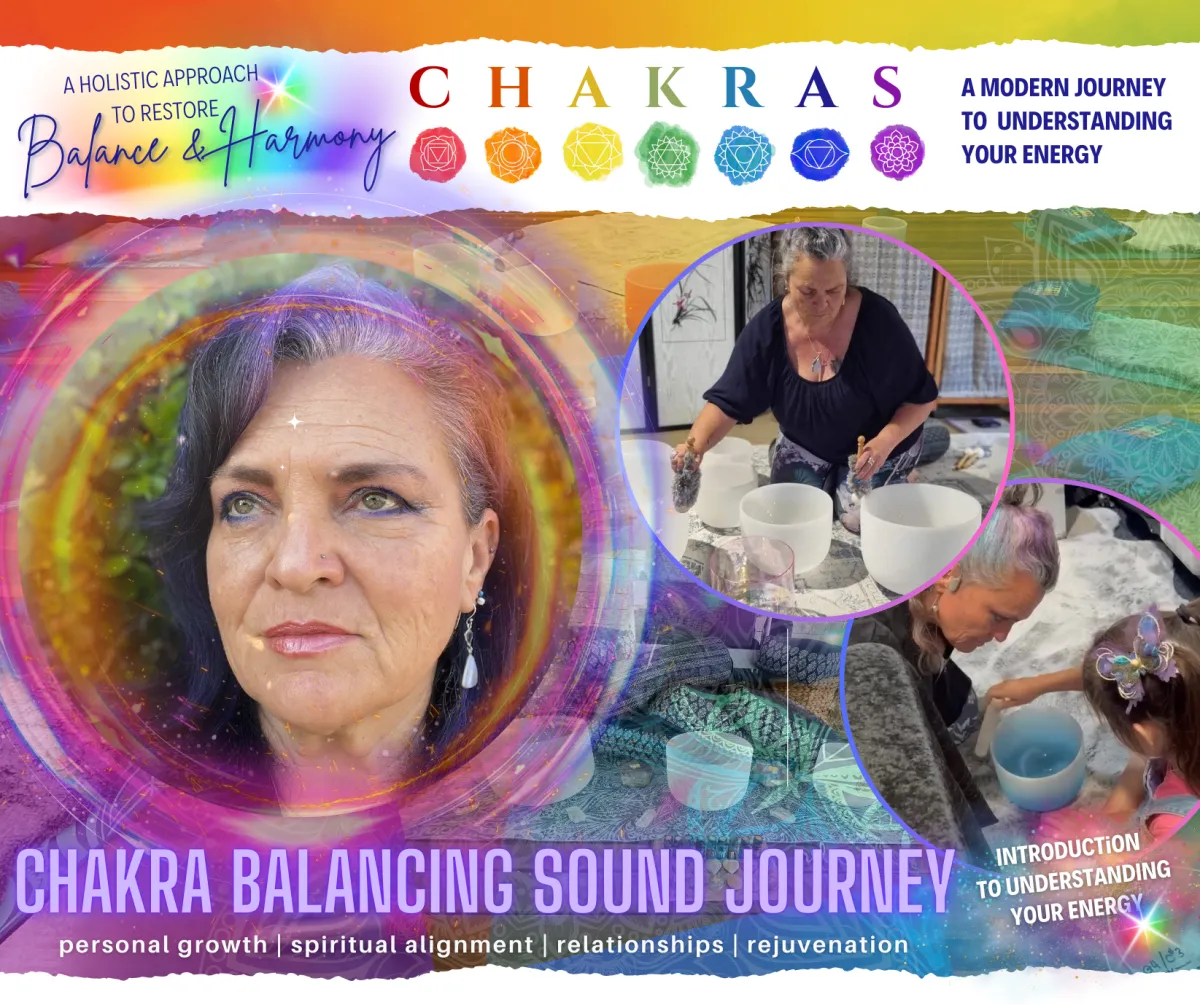

Beginners & Intermediate Workshops
Understanding your chakras and their attributes is important for maintaining balance and harmony in your physical, emotional, and spiritual well-being. Each chakra is associated with a specific area of the body and is linked to different emotions, behaviours, and mental states. By understanding the function and significance of each chakra, you can identify areas that need attention and work towards achieving optimal health and balance. Regularly practicing chakra-balancing exercises such as meditation, yoga, or energy healing can help improve your overall well-being and enhance your ability to handle stress and challenges in life.
Frequently Asked Questions
Welcome to our FAQs section, where we address common questions and provide helpful answers about our services, events, products and courses. Please feel free to reach out to us if you cannot find the answers you are looking for. For convenience I have also included a link on the right so you can have quick access to all our events listed on Humanitix.

What is A Sacred Sound Journey?
A sacred sound journey with crystal singing bowls is a meditative and healing experience that involves the use of crystal singing bowls to create sound vibrations intended to promote relaxation, harmony, and transformation. Here’s a more in-depth look at what this practice entails:
Key Elements:
1. Crystal Singing Bowls:
- Materials: These bowls are typically made from pure quartz crystal, which is believed to enhance vibrational healing properties.
- Sound Frequencies: Each bowl is tuned to specific frequencies that correspond to different energy centers (chakras) in the body, facilitating a deep sense of relaxation and healing.
2. Purpose of the Journey:
- Meditation and Mindfulness: Participants are guided into a meditative state, often lying down comfortably or sitting in a relaxed position.
- Healing and Transformation: The sound vibrations can promote physical, emotional, and spiritual healing. Some people may experience shifts in energy, inner peace, or insights during the journey.
- Stress Reduction: The soothing sounds help in reducing stress, anxiety, and tension, creating a calming atmosphere.
3. Structure of the Journey:
- Guidance: Typically led by a facilitator, who may offer intentions or prompts to help participants set their personal goals for the experience.
- Sound Bath: The bowls are played in a sequence, usually creating a sound bath where participants immerse themselves in the resonating frequencies.
- Integration: After the sound journey, there is often time for reflection, journaling, or sharing experiences, allowing participants to integrate what they have felt or discovered.
4. Benefits:
- Physical Benefits: Some claim reductions in pain, improved circulation, and enhanced sleep quality.
- Emotional and Mental Clarity: The sound can help release negative emotions, enhance creativity, and provide clarity of thought.
- Spiritual Connection: Many find that such experiences deepen their connection to self and their spiritual journeys.
5. Setting:
- Sacred Space: These journeys are often conducted in peaceful environments (such as wellness centers, yoga studios, or nature) designed to enhance the meditative experience.
- Decorations and Atmosphere: Soft lighting, comfortable mats, and elements like candles, incense, or essential oils may be used to create a serene atmosphere.
Conclusion
A sacred sound journey with crystal singing bowls is a profound and transformative experience, combining sound, meditation, and healing to foster relaxation and personal insight. Whether you are seeking stress relief, emotional healing, or spiritual growth, this practice can offer a unique pathway to deeper self-awareness and holistic well-being.
What is the difference between a soundbath, a sound journey or sound therapy session?
The terms soundbath, sound journey, and sound therapy session are often used interchangeably in wellness and spiritual communities, but they can reflect slightly different experiences or focal points. Below is a breakdown of each term and their distinctions:
1. Sound Bath
Definition: A sound bath is a meditative experience where participants are immersed in sound waves produced by various instruments, such as singing bowls, gongs, chimes, and other resonant instruments.
Characteristics:
- Immersion in Sound: Participants typically lie down or sit in a comfortable position while the sounds wash over them. The focus is primarily on listening and experiencing the vibrations.
- Duration: Sound baths usually last from 45 minutes to an hour or more.
- Intention: The intention may often be to provide relaxation, stress relief, and a meditative experience, with less emphasis on personal exploration or specific themes.
- Setting: Conducted in group settings, often with multiple participants.
2. Sound Journey
Definition: A sound journey is a more guided experience that incorporates sound, storytelling, and often visualization, taking participants on a metaphorical journey meant to evoke a deeper emotional response or spiritual insights.
Characteristics:
- Guided Experience: Led by a facilitator who may use verbal cues, visualization, or storytelling to enhance the experience and guide participants through various emotional or spiritual landscapes.
- Length and Structure: Sessions can vary in length but may also include elements of breathwork, movement, or meditation along with sound.
- Emphasis on Inner Exploration: Participants are encouraged to connect with their inner thoughts, feelings, and intentions during the journey, often focusing on personal themes or goals.
- More Individual Experience: While often held in groups, there is a stronger emphasis on personal reflection and inner work compared to a sound bath.
3. Sound Therapy Session
Definition: Sound therapy is a broader concept that employs sound as a therapeutic tool to address physical, emotional, and psychological issues. It often incorporates a variety of sound modalities and personalized techniques based on individual needs.
Characteristics:
- Therapeutic Focus: Sessions are typically tailored to address specific issues such as stress, anxiety, trauma, or physical pain. They may incorporate diagnostic techniques to understand the participant's needs.
- Variety of Techniques: May include a combination of sound baths, guided meditation, voice, and other sound-producing techniques (like tuning forks or vocal toning) tailored to the person’s specific healing requirements.
- Professional Setting: Generally conducted by trained practitioners or therapists who may have backgrounds in psychology, counseling, or holistic health.
- Length and Format: Sessions can vary widely in length and are often one-on-one, allowing for a deeper focus on individual healing.
Conclusion
While all three experiences utilize sound as a central component for relaxation and healing, their approaches and intentions differ. Participants interested in exploring their emotional or spiritual landscape might lean toward a sound journey, while those seeking relaxation might prefer a sound bath. Sound therapy is ideal for those looking for specific therapeutic outcomes in a more clinical or therapeutic context.
What to expect at a sound journey or a soundbath?
Attending a sound journey or sound bath can be a deeply relaxing and transformative experience. Here’s what you can generally expect from each type of session:
What to Expect at a Sound Journey
1. Setting and Atmosphere:
- Comfortable Space: The session is usually held in a quiet and comfortable setting, such as a yoga studio, wellness center, or any peaceful environment. It may be dimly lit and decorated with soft textiles to create a calming atmosphere.
- Relaxing Decor: You might find cushions, mats, blankets, and possibly calming elements like candles or incense to enhance the ambiance.
2. Arrival and Preparation:
- Arrival Time: It’s recommended to arrive a little early to settle in and get comfortable before the session begins.
- Intention Setting: The facilitator may encourage participants to set personal intentions or goals for the journey. This could be shared aloud or kept private.
3. Guided Visualization:
- Facilitator Guidance: You can expect the facilitator to lead you through a guided visualization or meditation, often incorporating storytelling elements that help you delve deeper into your inner experience.
- Focused Themes: The sound journey may center around specific themes (e.g., healing, letting go, or self-discovery) which can facilitate personal exploration.
4. Sound Experience:
- Instrumentation: Crystal singing bowls, gongs, chimes, and other instruments will be played, creating rich soundscapes tailored to enhance the journey.
- Personal Experience: As you relax, you may experience various sensations, emotions, or insights. It is common for people to drift in and out of consciousness during this process.
5. Integration Time:
- Reflection: After the journey, participants may have a moment to reflect, journal, or share their experiences if desired. This helps in integrating the insights or emotions that surfaced during the journey.
What to Expect at a Sound Bath
1. Setting and Atmosphere:
- Similar Environment: Like a sound journey, a sound bath occurs in a serene environment with soft lighting and comfortable seating or lying arrangements.
- Comfort Items: Participants typically have mats, blankets, and pillows to ensure comfort throughout the session.
2. Arrival and Preparation:
- Check-In: Arrive early to settle in, and participants may be encouraged to set a personal intention, though this may not be emphasized as heavily as in a sound journey.
3. Immersion in Sound:
- Duration: A sound bath usually lasts between 45 minutes to an hour.
- Listening Experience: The facilitator plays a variety of instruments (often focusing on singing bowls) that create a harmonic, immersive sound experience. You will primarily be in a listening mode, focusing on absorbing the sound vibrations.
4. Relaxation and Drift:
- Deep Relaxation: Many participants experience profound relaxation, often entering a meditative state or a light trance. Some may feel sensations like tingling or warmth as the sound waves resonate in their bodies.
- No Participation Required: Unlike a sound journey, there may be less verbal guidance. Instead, the focus is on the pure experience of the sounds.
5. Closing and Integration:
- Gentle Return: At the end of the sound bath, participants are gently guided to return to a state of awareness. There may be a few moments of silence before participants sit up or stretch.
- Reflection: Depending on the facilitator, there may be time for participants to share experiences or reflect on feelings and thoughts evoked during the bath.
General Tips for Both Sessions
- Dress Comfortably: Wear loose, comfortable clothing to help facilitate relaxation.
- Hydrate: Drink water before and after the session to stay hydrated and to help flush out any toxins that may be released during the experience.
- Open Mind: Approach the session with an open mind and heart. Your experience may vary from session to session, and openness can enhance your journey.
- No Expectations: Allow yourself to be fully present and let go of any expectations regarding what you should feel or experience.
Conclusion
Both a sound journey and a sound bath offer unique experiences focused on relaxation, healing, and inner exploration. The primary difference lies in the added narrative and guidance of a sound journey compared to the more auditory immersion of a sound bath. Regardless of the session type, participants often leave feeling refreshed, balanced, and more connected to themselves.
Can children attend a sound journey or soundbath?
Yes, children can attend sound journeys or sound baths, and many practitioners welcome families to share in these experiences. We
However, there are several considerations to keep in mind regarding their participation:
Considerations for Children Attending Sound Journeys or Sound Baths
1. Age Appropriateness:
- Different sessions may be more suitable for certain age groups. Some facilitators may offer family-friendly sound baths or journeys specifically designed for children, incorporating elements suitable for their age and attention spans.
2. Focus and Engagement:
- Children may have shorter attention spans than adults, so it’s essential to consider whether they will be able to engage with the experience. Sessions designed for both children and adults might include more interactive or playful elements.
3. Parental Supervision:
- Adult supervision is typically required. Parents or guardians should be present to help guide and support their children during the experience.
4. Comfort and Environment:
- Sound journeys and baths can involve deep relaxation, which might be new for some children. It’s important to ensure that the environment feels safe and comfortable for them. Parents can help by bringing favorite blankets, pillows, or comfort items.
5. Preparation:
- It can be helpful to explain what to expect during the session to children. Discuss the sounds they will hear, how they might feel, and the importance of being quiet and still during the experience.
6. Facilitator’s Policies:
- Always check with the facilitator regarding their policy on children attending. Some may have age limits or specific guidelines to follow. They may have child-friendly sessions or programs designed with the needs of younger participants in mind.
7. Sensory Sensitivity:
- Consider whether the child has any sensitivities to sound, as the vibrations from instruments like singing bowls can be intense. Some children may find the experience soothing, while others might feel overwhelmed.
8. Effects on Children:
- Many children respond positively to sound experiences, benefiting from relaxation and stress relief. They may also enjoy the creative and imaginative aspects of a sound journey.
Benefits for Children
- Relaxation: Sound baths and journeys can help children learn how to relax and manage stress in a safe environment.
- Emotional Expression: These experiences can promote emotional awareness and expression.
- Mindfulness: Engaging in such practices can introduce children to mindfulness and meditation techniques at an early age.
- Connection: Participating in a sound journey or bath can strengthen bonds between family members as they share the experience together.
Conclusion
In summary, children can attend sound journeys and sound baths, but careful consideration is needed to ensure the experience is appropriate and beneficial for them. Parental involvement, attention to comfort, and an understanding of the child’s needs and sensitivities will enhance the experience. If possible, look for sessions specifically designed for families or younger participants to ensure a positive and fulfilling experience for everyone involved.
What are the benefits of a sacred sound experience?
We prepare our “Sacred Sound Sanctuary” to create a safe space for you to explore a journey of personal discovery to restore balance and harmony. Our Wellness and Sacred Sound tools, events and services allow you to experience a unique and meaningful connection with your self, heart mind, body and soul. This is a space for you to retreat in order to rejuvenate your body, relax your mind, restore your heart and calm your emotions. This is a deeply nourishing, private & intrinsic, holistic self-care treatment. This experience is intuitively tailored for you to be full guided on your own Personalised “Ultimate” Sacred Wellness Journey.
How Does Sound Therapy Work?
Therapeutic sound can balance and harmonize us, it can act as an energetic body builder and cleanser, and help us on our journey to spiritual unfolding and wholeness. It allows old, stagnant and unhealthy energies to be cleared away, transformed and replaced with new, clear, pure, harmonic vibrational energies. It restores our natural resonance, bringing us from a state of disharmony, manifesting as stress, tension and dis-ease; to a state of balance, peace and harmony that leads ultimately to ease and positive well-being.
Why is it necessary to Restore Balance & Harmony Regularly?
Our lives are stressed and Toxic load from our environment and everyday lifestyle impact us, such as:
∆ Stress & Anxiety
∆ Financial Stress
∆ Lack of sleep
∆ Diet & Exercise
∆ Lifestyle factors
∆ Relationships
∆ Responsibility
∆ Toxins & Environmental Threats
…can deplete our energy and zest for life. Long-term impacts of these stressors affect our…
∆ Wellbeing & Immunity
∆ Cognitive Functioning
∆ Emotional Stability
∆ Heightened Flight and Flight Responses and are also pre-cursors for:
> Anxiety, > Addiction, > Depression, > Disconnection and > Disease.
These impacts lead our bodies, minds and hearts out of harmony
and balance and stop us from living out of our full potential.
We have a Variety of Therapuetic RESTORE Protocols Available for you to choose from…
∆ ADHD & ADD
∆ Depression
∆ Energy Body Balance
∆ Grief & Loss
∆ Hormonal Imbalance
∆ Immunity & Disease
∆ Mindset and Mental Health
∆ Moods & Emotion
∆ Past Life & Childhood Trauma
∆ Relationship Distress
∆ Relaxation & Sleep
∆ Rejuvenation & Restoration
∆ Self Esteem
∆ Stress & Anxiety
∆ Weight Management
What problems can be solved with guided sacred sound journeys?
Sound therapy and guided meditation can address a variety of physical, emotional, and psychological issues. Here are some problems that can be effectively managed or alleviated through these practices:
1. Stress and Anxiety
- Problem: Individuals experiencing high levels of stress and anxiety can benefit from relaxation techniques.
- Solution: Sound therapy uses soothing sounds (like crystal bowls or tuning forks) combined with guided meditations to promote deep relaxation and reduce anxiety levels.
2. Sleep Disorders
- Problem: Insomnia or poor-quality sleep affects many people's health and well-being.
- Solution: Guided meditations that utilize calming sounds can help induce relaxation, making it easier to fall asleep and stay asleep.
3. Chronic Pain Management
- Problem: Conditions such as fibromyalgia or arthritis can cause persistent pain.
- Solution: Sound therapy may reduce the perception of pain and promote relaxation, while guided meditation can help individuals develop better coping strategies.
4. Emotional Regulation
- Problem: Difficulty managing emotions, such as anger or sadness, can affect relationships and quality of life.
- Solution: Guided meditations focusing on emotional release, in combination with sound therapy, can help individuals process and regulate their emotions more effectively.
5. Focus and Concentration Issues
- Problem: Difficulty concentrating can hinder productivity and learning.
- Solution: Sound therapy with specific frequencies can promote mental clarity, while guided meditation can enhance focus and concentration techniques.
6. Depression and Low Mood
- Problem: Persistent low mood or depression requires effective coping strategies.
- Solution: Sound therapy can elevate mood through uplifting sounds, while guided meditation can help promote positive thinking and self-acceptance.
7. Trauma Recovery
- Problem: Individuals struggling with PTSD or trauma may find it challenging to cope with their experiences.
- Solution: Guided meditations tailored to trauma recovery, reinforced by soothing sounds, can create a safe space for healing and processing emotions.
8. Spiritual Disconnect
- Problem: Some individuals may feel spiritually disconnected or seek a deeper understanding of their purpose.
- Solution: Sound therapy and guided meditation can facilitate spiritual awakening and enhance mindfulness practices, helping individuals connect with their inner selves.
9. Workplace Burnout
- Problem: Burnout from work stress can lead to decreased productivity and job satisfaction.
- Solution: Implementing sound therapy and guided meditation sessions can help employees decompress, recharge, and improve overall workplace morale.
10. Physical Tension and Muscle Relaxation
- Problem: Physical tension and stress build-up can lead to discomfort and pain.
- Solution: Sound therapy can help release physical tension, while guided meditation encourages body awareness and relaxation techniques.
11. Relationship Issues
- Problem: Communication and emotional connection can suffer in relationships due to stress and misunderstandings.
- Solution: Couples can use sound therapy and guided meditation to improve their emotional connection and enhance communication skills.
12. Addiction and Habit Change
- Problem: Overcoming addictions or changing negative habits can be challenging.
- Solution: Guided meditations can help individuals reflect on their triggers and motivations, while sound therapy promotes relaxation and reduces cravings.
13. Creative Blocks
- Problem: Artists and creators may experience blocks that hinder their inspiration and productivity.
- Solution: Sound therapy can stimulate creativity, while guided meditations can help individuals visualize their goals and unlock their creative potential.
Utilizing sound therapy and guided meditation provides a holistic approach to healing, addressing both the mind and body for improved overall well-being.
13. Lack of Direction and Purpose in Life B
- Problem: Becoming lost, blocked or misaligned with purpose in your life
- Solution: Sound therapy can align, unblock and inspire you to search within for answers, guided meditations can help individuals visualize their strengths, inner potential, passions annd dream and unlock their full potential.
Utilizing sound therapy and guided meditation provides a holistic approach to healing, addressing both the mind and body for improved overall well-being.
How can sound and guided meditation be helpful for relationships?
Toxic relationships can deeply affect an individual's mental, emotional, and physical well-being. Sound therapy and guided meditation can be powerful tools for healing and fostering healthier connections. Here are some types of toxic relationships that can benefit from these practices:
1. Romantic Relationships
- Nature of Toxicity: Distrust, jealousy, emotional abuse, or patterns of manipulation.
- Solution: Sound therapy can help individuals process negative emotions and empower them to set boundaries, while guided meditation can foster self-love and clarity regarding relationship dynamics.
2. Family Relationships
- Nature of Toxicity: Dysfunctional family patterns, such as constant criticism, control, or lack of support.
- Solution: Guided meditation can assist individuals in finding peace with their family dynamics, while sound therapy can help release deep-seated emotional pain and promote healing.
3. Friendship Conflicts
- Nature of Toxicity: Imbalance in effort, one-sided friendships, or betrayal.
- Solution: Sound therapy can help individuals reflect on their needs and feelings, while guided meditation can facilitate understanding, forgiveness, or the decision to distance oneself from a toxic friend.
4. Workplace Relationships
- Nature of Toxicity: Competition, bullying, or manipulation by colleagues or supervisors.
- Solution: Guided meditations designed to enhance resilience and emotional intelligence can assist in navigating workplace conflicts, while sound therapy may reduce work-related stress and anxiety.
5. Codependent Relationships
- Nature of Toxicity: An unhealthy reliance on each other for emotional support or validation.
- Solution: Sound therapy can help individuals recognize their own self-worth, while guided meditation can encourage independence and personal growth.
6. Unhealthy Parent-Child Dynamics
- Nature of Toxicity: Overprotectiveness, criticism, or neglect.
- Solution: Guided meditation for self-compassion can help individuals heal from childhood wounds, while sound therapy can promote emotional release and resilience.
7. Manipulative or Controlling Relationships
- Nature of Toxicity: One partner consistently makes decisions for the other or uses guilt and emotional coercion.
- Solution: Sound therapy can empower individuals to reclaim their voice, while guided meditation can facilitate clarity about their personal needs and autonomy.
8. Abusive Relationships (Emotional or Physical)
- Nature of Toxicity: Any form of abuse that undermines self-esteem and safety.
- Solution: While it's crucial for individuals in such situations to seek professional help, sound therapy and guided meditation can create a safe space for emotional healing and recovery.
9. Friendship or Social Circles with Negative Influence
- Nature of Toxicity: Peer pressure, condescension, or fostering unhealthy behaviors.
- Solution: Guided meditation can help individuals cultivate inner strength and clarity to choose healthier friendships, while sound therapy can promote self-acceptance and confidence.
10. Community or Group Dynamics
- Nature of Toxicity: Dysfunctional group behavior, such as exclusion, gossip, or judgment.
- Solution: Sound therapy can create a sense of unity and belonging, while guided meditation can encourage compassion and understanding, promoting healthier group interactions.
11. Neglectful Relationships
- Nature of Toxicity: Lack of communication, emotional unavailability, or disregard for feelings.
- Solution: Sound therapy can help individuals express unvoiced emotions, while guided meditation can assist in clarifying personal feelings and needs.
12. Interpersonal Conflicts Beyond Immediate Relationships
- Nature of Toxicity: Conflicts with acquaintances or community members leading to stress or anxiety.
- Solution: Individuals can utilise sound therapy and guided meditation to process their feelings and find a peaceful resolution or acceptance.
---
Benefits of Sound Therapy and Guided Meditation for Toxic Relationships:
- Emotional Release: Both practices facilitate the release of pent-up emotions such as anger, sadness, or frustration.
- Increased Self-Awareness: They promote introspection, helping individuals gain insights into their relationships and behaviors.
- Stress Reduction: These methods lower cortisol levels, aiding individuals in managing stress caused by toxic relationships.
- Empowerment: Sound therapy and meditation can enhance self-esteem and personal power, enabling individuals to take healthier actions.
- Clarity and Perspective: They provide mental clarity, allowing individuals to make informed decisions regarding their relationships.
Incorporating sound therapy and guided meditation into one’s routine can be a supportive step toward healing from toxic relationships and fostering healthier connections.
Can sound and guided meditation be used to overcome addiction?
Addictions can take many forms and often have complex psychological, emotional, and physical components. Sound therapy and guided meditation can provide valuable support in the recovery process by promoting relaxation}, reducing cravings, and fostering self-awareness. Here’s a brainstorm of common addictions that can potentially be addressed with these holistic practices:
1. Substance Abuse
- Types: Alcohol, prescription painkillers, recreational drugs.
- Solution: Sound therapy can help ease withdrawal symptoms and cravings, while guided meditation encourages self-reflection and coping strategies for triggers.
2. Food Addiction
- Types: Emotional eating, binge eating, or compulsive overeating.
- Solution: Guided meditation can cultivate mindfulness around eating habits, while sound therapy may assist in reducing stress and promoting a healthier relationship with food.
3. Nicotine Addiction
- Types: Cigarettes, vaping, or other forms of tobacco.
- Solution: Sound therapy can help manage cravings and reduce anxiety associated with withdrawal, while guided meditation encourages visualization of a smoke-free life.
4. Gambling Addiction
- Nature of Addiction: Compulsive gambling affecting finances, relationships, and mental health.
- Solution: Guided meditation promotes emotional regulation and coping mechanisms, while sound therapy can help relieve anxiety related to urges and cravings.
5. Shopping Addiction (Compulsive Buying)
- Nature of Addiction: Impulsive purchases affecting financial stability.
- Solution: Sound therapy can reduce stress and anxiety that may trigger compulsive shopping, while guided meditation helps develop awareness of emotional triggers behind spending.
6. Internet or Social Media Addiction
- Nature of Addiction: Excessive use of the internet or social media leading to negative impacts on daily life.
- Solution: Guided meditation can promote mindfulness and self-control, while sound therapy provides a calming environment to create healthier habits around tech use.
7. Gaming Addiction
- Nature of Addiction: Compulsive gaming impacting social, academic, or work life.
- Solution: Sound therapy can help alleviate stress and anxiety associated with gaming, while guided meditation fosters awareness about time management and personal goals.
8. Sex and Love Addiction
- Nature of Addiction: Compulsive sexual behaviors or unhealthy relationships.
- Solution: Guided meditation can assist individuals in exploring the underlying emotions behind their behaviours, while sound therapy promotes relaxation and self-acceptance.
9. Caffeine Addiction
- Nature of Addiction: Dependence on caffeine leading to withdrawal symptoms without it.
- Solution: Sound therapy can help with relaxation, making the transition away from caffeine smoother, while guided meditation helps in managing cravings and withdrawal effects.
10. Workaholism
- Nature of Addiction: Compulsive work habits impacting personal life and relationships.
- Solution: Guided meditation encourages work-life balance and self-care, while sound therapy can reduce stress and promote a sense of calm and relaxation.
11. Exercise Addiction
- Nature of Addiction: Compulsive exercising despite injury or exhaustion.
- Solution: Guided meditation can help individuals reconnect with their motivations and body signals, while sound therapy promotes a healthier relationship with fitness.
12. Emotional or Psychological Addictions
- Types: Codependency, need for validation, or chronic drama-seeking.
- Solution: Sound therapy can help break negative thought patterns, while guided meditation fosters self-awareness and inner peace, facilitating healing from emotional dependencies.
13. Addiction to Drama or Chaos
- Nature of Addiction: Seeking out tumultuous relationships or situations for excitement.
- Solution: Sound therapy creates a calming environment that encourages peace, while guided meditation helps individuals reflect on their choices and find fulfilment in stability.
Benefits of Sound Therapy and Guided Meditation for Addiction Recovery:
- Emotional Release: These practices help individuals process and release pent-up emotions that can fuel addictive behaviours.
- Stress Reduction: Regular practice lowers stress levels, reducing the likelihood of turning to addictive substances or behaviours for relief.
- Enhanced Self-Awareness: They promote introspection, helping individuals understand the underlying causes of their addictions.
- Improved Coping Strategies: Sound therapy and guided meditation encourage healthier ways to cope with cravings or emotional distress.
- Promotes Mindfulness: These techniques cultivate present-moment awareness, helping individuals recognize triggers and make conscious choices.
Incorporating sound therapy and guided meditation into addiction recovery programs can offer holistic support, helping individuals build resilience and foster healthier, more balanced lives.
Is Sound and guided meditation effective for spiritual awakening and development?
Spiritual awakening is a profound process that involves gaining deeper insights into one’s self, purpose, and connection to the universe. Sound therapy and guided meditation can be powerful tools in facilitating and enhancing this journey. Here are several aspects of spiritual awakening that can be supported through these practices:
1. Increased Self-Awareness
- Challenge: Many individuals feel disconnected from their true selves or unsure of their identity.
- Solution: Sound therapy helps quiet the mind, allowing for deeper introspection, while guided meditation can lead to insights about one’s values, beliefs, and purpose.
2. Emotional Healing
- Challenge: Past traumas and emotional blockages can hinder spiritual growth.
- Solution: Sound therapy can facilitate emotional release and healing, and guided meditation can help individuals confront and process unresolved emotions.
3. Inner Peace and Calmness
- Challenge: Busy lifestyles and external stressors can lead to feelings of chaos and unrest.
- Solution: Sound therapy creates a soothing atmosphere, promoting relaxation, while guided meditation fosters a sense of inner peace and tranquility, essential for spiritual reflection.
4. Enhanced Intuition
- Challenge: Many individuals struggle to trust their intuition or inner voice.
- Solution: Guided meditation can encourage participants to tune into their inner guidance, while sound therapy enhances intuitive awareness through resonance and vibration.
5. Deepening Meditation Practices
- Challenge: Individuals may find it difficult to enter deep states of meditation or may experience distractions.
- Solution: Sound therapy (using singing bowls, gongs, or ambient music) can aid in achieving deeper meditative states, while guided meditation provides structured paths to explore spirituality.
6. Connection to the Higher Self
- Challenge: Difficulty in experiencing or understanding the concept of the higher self or soul essence.
- Solution: Sound therapy can help create a resonance that facilitates connection to higher consciousness, while guided meditation often includes visualizations to connect with the higher self.
7. Grounding and Centering
- Challenge: People may feel ungrounded or disconnected from the earth and physical reality.
- Solution: Sound therapy can promote grounding by using bass-heavy instruments, and guided meditation techniques can focus on root chakra awareness and connecting to Mother Earth.
8. Awareness of Energy Centers (Chakras)
- Challenge: Blockages or imbalances can affect spiritual and emotional well-being.
- Solution: Sound therapy specifically tuned to different frequencies for each chakra can help to balance and align energy centers, while guided meditations can incorporate chakra visualization and healing practices.
9. Finding Purpose and Direction
- Challenge: Many people grapple with existential questions regarding their purpose and life path.
- Solution: Guided meditation can facilitate exploration of personal passions and purpose, while sound therapy can help clear mental clutter to allow for clarity in life decisions.
10. Connection to the Universe
- Challenge: Feelings of isolation or disconnection from the universe and humanity as a whole.
- Solution: Sound therapy can evoke feelings of oneness and universal connection, while guided meditation can incorporate themes of interconnectedness and unity with all beings.
11. Transcending Fear
- Challenge: Fears and anxieties can impede spiritual growth and exploration.
- Solution: Sound therapy can create a safe space that promotes surrender and trust, and guided meditation can help address and release fears.
12. Awakening Psychic Abilities
- Challenge: Individuals may feel they have untapped intuitive or psychic abilities but need guidance.
- Solution: Sound therapy can enhance psychic development by raising vibrational awareness, while guided meditations can focus on honing intuitive skills and receiving messages from intuitive sources.
13. Manifestation and Abundance
- Challenge: Limiting beliefs can hinder individuals from achieving their desires and goals.
- Solution: Guided meditation can include visualization techniques for manifestation, while sound therapy can elevate vibrational energies to attract abundance.
14. Spiritual Guidance and Support
- Challenge: Navigating a spiritual path can sometimes feel lonely or uncertain.
- Solution: Guided meditations can invite participants to connect with spirit guides or higher guidance, while sound therapy can create a communal environment for like-minded individuals.
15. Integration of Spiritual Experiences
- Challenge: Individuals may struggle with integrating profound spiritual experiences into everyday life.
- Solution: Sound therapy can facilitate grounding after deep spiritual experiences, while guided meditation can help articulate and understand these experiences.
Benefits of Sound Therapy and Guided Meditation in Spiritual Awakening:
- Holistic Approach: These practices engage the mind, body, and spirit, fostering overall well-being.
- Enhanced Mindfulness: Regular practice encourages present-moment awareness, crucial for spiritual clarity.
- Facilitated Connection: Both sound therapy and guided meditation open pathways for deeper exploration of spirituality and connection to the self and the universe.
- Improved Emotional Stability: Participants often experience enhanced emotional regulation, which is vital for spiritual journeys.
- Community and Support: Group sound therapy and meditation sessions provide a sense of belonging and shared experience during spiritual awakening.
Integrating sound therapy and guided meditation into a spiritual awakening journey can offer profound support, guiding individuals towards deeper self-discovery, healing, and connection to their higher selves.
What are the next steps using sound and guided meditation to advance spiritual growth?
Spiritual development is a multifaceted journey aimed at enhancing one’s understanding of self, purpose, and connection to the universe. Sound therapy and guided meditation can provide powerful support in various aspects of spiritual growth. Here’s a brainstorm of areas in spiritual development that can be enhanced through these practices:
1. Self-Discovery
- Challenge: Individuals often struggle to understand their true selves, values, and beliefs.
- Solution: Guided meditation can facilitate introspective journeys, while sound therapy encourages relaxation, allowing for deeper insights into one's identity and purpose.
2. Emotional Healing
- Challenge: Unresolved emotional wounds can block spiritual growth.
- Solution: Sound therapy helps release trapped emotions, while guided meditation can guide individuals through the process of healing and forgiveness.
3. Connection with the Higher Self
- Challenge: Many seek to connect with their higher self or inner wisdom.
- Solution: Sound therapy creates a resonant environment that promotes this connection, while guided meditation often includes practices to align with the higher self for guidance and insight.
4. Mindfulness and Presence
- Challenge: Busy minds can distract from spiritual practices and awareness.
- Solution: Sound therapy, such as singing bowls or ambient music, aids in fostering a meditative state, while guided meditations develop mindfulness and presence in everyday life.
5. Intuitive Development
- Challenge: Individuals may seek to enhance their intuition or psychic abilities.
- Solution: Sound therapy can raise vibrational frequencies that facilitate intuitive insights, while guided meditations can include exercises focused on tuning into intuitive feelings.
6. Chakra Balancing
- Challenge: Blocked or imbalanced chakras can affect spiritual and emotional health.
- Solution: Sound therapy utilising specific frequencies for each chakra can aid in restoring balance, while guided meditations can focus on visualising and healing these energy centres.
7. Stress Reduction and Relaxation
- Challenge: Stress can hinder spiritual growth and clarity.
- Solution: Sound therapy can reduce stress through calming vibrations, while guided meditation practices promote deep relaxation and mental stillness.
8. Spiritual Connection and Unity
- Challenge: Feelings of isolation can hinder spiritual development and connection with others.
- Solution: Group sound therapy sessions foster a sense of community and shared experience, while guided meditations can focus on themes of interconnectedness and unity with all beings.
9. Clarity of Purpose
- Challenge: Individuals may feel lost or uncertain about their life purpose.
- Solution: Guided meditation can help clarify personal goals and passions, while sound therapy encourages deeper exploration of one's values and intentions.
10. Grounding Techniques
- Challenge: Many individuals struggle with feeling grounded, especially during intense spiritual experiences.
- Solution: Sound therapy can promote a sense of grounding through resonant frequencies, while guided meditations can focus on rooting oneself in the earth and the present moment.
11. Enhanced Creativity
- Challenge: Blockages can stifle creative expression, which is often linked to spiritual development.
- Solution: Sound therapy stimulates creativity through relaxing vibrations, while guided meditation can release inhibitions and encourage free expression.
12. Life Transitions and Change
- Challenge: Navigating significant life changes can be daunting and may disrupt spiritual progress.
- Solution: Guided meditation can provide support during transitions, fostering acceptance and understanding, while sound therapy can promote feelings of safety and stability.
13. Building Resilience and Strength
- Challenge: Individuals may find it challenging to overcome obstacles along their spiritual path.
- Solution: Sound therapy can enhance feelings of empowerment, while guided meditation encourages strategies for resilience and personal growth.
14. Developing Compassion and Empathy
- Challenge: Spiritual growth often requires the development of compassion for oneself and others.
- Solution: Guided meditations focusing on loving-kindness can cultivate empathy, while sound therapy promotes relaxation and openness to understanding others.
15. Understanding and Integrating Spiritual Experiences
- Challenge: Profound spiritual experiences may be difficult to process or integrate into daily life.
- Solution: Sound therapy can facilitate grounding, while guided meditation can offer reflection and understanding of these experiences.
16. Awakening Spiritual Gifts
- Challenge: Many individuals feel they possess untapped spiritual gifts but are unsure how to access them.
- Solution: Guided meditation can include practices that awaken spiritual abilities, while sound therapy can vibrationally align one to these gifts.
Benefits of Sound Therapy and Guided Meditation in Spiritual Development:
- Holistic Approach: Engaging both the mind and body, these practices promote overall well-being and foster spiritual growth.
- Stress Relief: Reducing stress levels enables deeper connection to spiritual practices and insights.
- Increased Awareness: Enhancing mindfulness fosters clearer perception of one’s spiritual path and experiences.
- Community Connection: Shared group experiences promote feelings of belonging and mutual support along spiritual journeys.
Incorporating sound therapy and guided meditation into spiritual development practices can significantly enhance the journey towards self-discovery, emotional healing, and a deeper understanding of one's place in the universe.
What physical, mental or emotional wellness is improved by sound and meditation?
Sound therapy and guided meditation offer a holistic approach to managing various illnesses and pain conditions by promoting relaxation, reducing stress, and fostering emotional well-being. Here’s a brainstorm of specific illnesses and pain conditions that can be improved with these practices:
1. Chronic Pain Conditions
- Examples: Fibromyalgia, arthritis, lower back pain.
- Solution: Sound therapy can promote relaxation and help reduce the perception of pain, while guided meditation can encourage focus and mental coping strategies.
2. Muscle Tension and Strain
- Examples: Tension headaches, muscle tightness.
- Solution: Sound therapy creates a soothing atmosphere that aids in muscle relaxation, while guided meditation can target feelings of tension and promote mindfulness around body awareness.
3. Migraines and Headaches
- Example: Tension headaches and migraines.
- Solution: Sound therapy with calming frequencies can help alleviate headache symptoms, while guided meditation can focus on relaxing techniques and visualisations to ease discomfort.
4. Anxiety and Stress-Related Disorders
- Examples: Generalized anxiety disorder (GAD), panic attacks.
- Solution: Sound therapy reduces stress and anxiety levels, promoting a sense of calm, while guided meditation provides coping strategies to manage anxiety and panic.
5. Depression
- Example: Major depressive disorder, seasonal affective disorder (SAD).
- Solution: Sound therapy and guided meditation can help elevate mood, foster emotional release, and encourage a positive mindset.
6. Sleep Disorders
- Examples: Insomnia, sleep apnea.
- Solution: Sound therapy promotes relaxation and prepares the mind for sleep, while guided meditation helps calm racing thoughts and establish a restful bedtime routine.
7. Digestive Issues
- Examples: Irritable bowel syndrome (IBS), stress-induced indigestion.
- Solution: Sound therapy reduces stress and promotes relaxation, which can positively influence digestion, while guided meditation can focus on calming the mind and body for better digestive health.
8. Post-Traumatic Stress Disorder (PTSD)
- Solution: Sound therapy can create a safe soundscape for processing trauma, while guided meditation provides tools for grounding and coping with distressing memories.
9. Chronic Fatigue Syndrome
- Solution: Sound therapy promotes relaxation and restorative energy, while guided meditation encourages mental clarity and mindfulness that may reduce fatigue.
10. Cancer and Oncology Care
- Example: Patients undergoing treatment for cancer.
- Solution: Sound therapy can help create a calming environment during treatment, while guided meditation assists in managing pain and anxiety associated with diagnosis or treatment.
11. Cardiovascular Issues
- Examples: High blood pressure, heart disease.
- Solution: Sound therapy can lower blood pressure and heart rate, while guided meditation emphasizes relaxation techniques that support cardiovascular health.
12. Respiratory Conditions
- Examples: Asthma, chronic obstructive pulmonary disease (COPD).
- Solution: Sound therapy can help regulate breathing, while guided meditation encourages relaxation of the respiratory muscles and promotes deeper, calmer breaths.
13. Chronic Inflammation
- Examples: Autoimmune disorders like rheumatoid arthritis or lupus.
- Solution: Sound therapy can help reduce stress and inflammation, while guided meditation focuses on healing visualisations and positive affirmations.
14. Recovery from Surgery or Trauma
- Solution: Sound therapy can enhance relaxation and promote healing, while guided meditation helps with pain management and emotional support during recovery.
15. Neuropathic Pain
- Example: Diabetic neuropathy, postherpetic neuralgia.
- Solution: Sound therapy can assist in reducing the perception of pain and promote relaxation, while guided meditation encourages coping strategies and mindfulness.
16. Hormonal Imbalances
- Example: Conditions like endometriosis or menopause symptoms.
- Solution: Sound therapy can help alleviate mood swings and discomfort, while guided meditation may provide relaxation and balance for emotional upheaval.
17. Sleep Apnea and Snoring
- Solution: Sound therapy can create a serene sleep environment, while guided meditation promotes mindful breathing techniques to reduce nighttime disturbances.
18. Mental Health Disorders
- Examples: Schizophrenia, bipolar disorder, obsessive-compulsive disorder (OCD).
- Solution: While sound therapy and guided meditation should complement therapeutic treatments, they can create a calming effect and promote mental stability.
Benefits of Sound Therapy and Guided Meditation in Managing Illness and Pain:
- Reduced Stress and Anxiety: Both practices lower cortisol levels, contributing to overall physical and mental well-being.
- Enhanced Relaxation: Promoting relaxation helps to alleviate muscular tension and reduces pain perception.
- Improved Emotional Well-Being: Encouraging a positive outlook and emotional release can improve the overall quality of life for individuals facing chronic illness or pain.
- Greater Mind-Body Connection: These practices foster awareness of the body and its sensations, aiding in coping with pain.
By integrating sound therapy and guided meditation into treatment plans, individuals can find relief, healing, and a greater sense of well-being when managing illnesses and pain.
What metaphysical issues can be improved by sound and guided meditation?
Metaphysical issues often involve the exploration of spiritual, philosophical, and existential questions, which can affect an individual's emotional and psychological well-being. Sound therapy and guided meditation can provide profound support for addressing these complexities. Here are several metaphysical issues that can be improved with these practices:
1. Spiritual Disconnection
- Challenge: Individuals may feel disconnected from their spiritual essence or the universe.
- Solution: Sound therapy promotes an atmosphere conducive to spiritual exploration, while guided meditation can help facilitate reconnection with one’s higher self or spiritual source.
2. Existential Crises
- Challenge: Questions about life’s purpose and meaning can lead to confusion and anxiety.
- Solution: Guided meditation can help individuals navigate existential questions, while sound therapy can create a tranquil space for introspection and discovery.
3. Past Life Exploration
- Challenge: A desire to understand past life experiences or unresolved issues from previous incarnations.
- Solution: Sound therapy can help induce a meditative state suitable for past life regression, while guided meditation can lead individuals through specific visualisations related to past lives.
4. Karmic Patterns
- Challenge: Difficulty in recognising or breaking free from recurring life patterns or cycles.
- Solution: Sound therapy helps clear the mind, making it easier to identify karmic lessons, while guided meditation provides tools for releasing karmic ties and creating new intentions.
5. Chakra Imbalances
- Challenge: Blocked or imbalanced energy centers can affect emotional and spiritual health.
- Solution: Sound therapy uses specific frequencies to align and balance the chakras, while guided meditation can focus on visualising each chakra's energy flow.
6. Fear of the Unknown
- Challenge: Anxiety around death, the afterlife, or the unknown aspects of existence.
- Solution: Sound therapy promotes relaxation, easing fears, while guided meditation can explore themes of death and rebirth, fostering acceptance and understanding of the unknown.
7. Connection to Spiritual Guides
- Challenge: Individuals may feel unsure of their connection with spirit guides or angels.
- Solution: Guided meditation can specifically invite connection with spiritual guides, while sound therapy creates an environment conducive to spiritual communication.
8. Manifestation and Intention Setting
- Challenge: Difficulty in manifesting desires or setting intentions effectively.
- Solution: Guided meditation can help clarify and focus intentions, while sound therapy aligns energy to amplify manifestation practices.
9. Energy Clearing
- Challenge: Accumulated negative energy or emotional residue can affect overall well-being.
- Solution: Sound therapy can help cleanse and clear stagnant energy, while guided meditation can provide techniques for energetic release and renewal.
10. Developing Intuition and Psychic Abilities
- Challenge: Difficulty in trusting one’s intuition or exploring psychic abilities.
- Solution: Sound therapy can enhance intuitive awareness, while guided meditation can include practices focusing on developing and trusting one’s intuition.
11. Understanding Life Lessons
- Challenge: Finding meaning in personal challenges or life traumas.
- Solution: Guided meditation can foster reflection on personal growth, while sound therapy can help process emotions related to these lessons.
12. Existential Suffering
- Challenge: Struggles with feelings of despair, meaninglessness, or nihilism.
- Solution: Sound therapy can create an uplifting environment, while guided meditation encourages hope, purpose, and the exploration of existential themes.
13. Dream Interpretation and Lucid Dreaming
- Challenge: Difficulty in recalling, interpreting, or controlling dreams.
- Solution: Sound therapy can enhance the quality of sleep, promoting better dream recall, while guided meditation can focus on dream visualization techniques for interpretation and lucidity.
14. Soul Retrieval and Healing
- Challenge: Individuals may feel fragmented or emotionally detached from their soul essence.
- Solution: Sound therapy can help restore energetic balance, while guided meditation can lead individuals through the process of soul retrieval and integration.
15. Connecting with Nature and the Universe
- Challenge: A sense of separation from nature and universal energies.
- Solution: Sound therapy can mimic natural sounds, promoting connection, while guided meditation can emphasise becoming one with nature and the cosmos.
16. Developing Compassion and Empathy
- Challenge: Struggling to connect with others or understand differing perspectives.
- Solution: Guided meditation focused on loving-kindness can foster empathy, while sound therapy can create a calming atmosphere conducive to compassionate reflection.
17. Resistance to Change
- Challenge: Fear or reluctance to embrace change or new beginnings.
- Solution: Sound therapy can ease anxiety associated with change, while guided meditation can facilitate acceptance and openness to new experiences.
18. Integration of Spiritual Experiences
- Challenge: Difficulty in processing or integrating profound spiritual experiences or awakenings.
- Solution: Sound therapy helps create a safe space for reflection, while guided meditation can support the articulation and understanding of spiritual experiences.
Conclusion:
Integrating sound therapy and guided meditation into practices addressing metaphysical issues can provide individuals with deeper insights, profound healing, and a stronger connection to their spiritual selves. By fostering relaxation and enhancing self-awareness, these practices facilitate personal growth, encourage exploration, and promote emotional well-being.
Can sound and meditation be useful for exploring multidimensional facets of our selves?
Exploring multidimensional experiences involves delving into various layers of consciousness, self-awareness, and the interconnectedness of existence. Sound therapy and guided meditation can significantly enhance these explorations by creating conducive environments for deep introspection, sensory expansion, and spiritual encounters. Here are several multidimensional experiences that can be explored with these practices:
1. Past Life Regression
- Experience: Exploring previous incarnations to uncover patterns or lessons.
- Approach: Sound therapy can induce a deep meditative state, while guided meditation leads participants through visualisations to access memories from past lives.
2. Astral Projection
- Experience: The sensation of separating consciousness from the physical body to explore other realms.
- Approach: Sound therapy uses specific frequencies to induce relaxation, while guided meditation focuses on techniques for safe astral travel and exploration of different dimensional spaces.
3. Channeling Higher Consciousness
- Experience: Connecting with higher dimensions or spiritual guides for guidance and wisdom.
- Approach: Sound therapy creates a resonant space for communication, while guided meditation invites participants to open themselves up to messages from higher sources.
4. Visualizing Potential Futures
- Experience: Exploring different life paths and their potential outcomes.
- Approach: Sound therapy can calm the mind for clarity, while guided meditation allows participants to visualise and feel the impact of various choices on their lives.
5. Connecting with Universal Consciousness
- Experience: Feeling the interconnectedness of all beings and elements in the universe.
- Approach: Sound therapy can mimic natural sounds or universal vibrations, while guided meditation encourages participants to experience a oneness with the cosmos.
### 6. Exploration of Alternate Realities
- Experience: Delving into the idea of parallel universes or alternate life paths.
- Approach: Sound therapy can create an immersive atmosphere, while guided meditations facilitate visualization techniques for experiencing different timelines or realitie
7. Timelessness and Presence
- Experience: Breaking free from linear time perception to experience the essence of "now."
- Approach: Sound therapy can focus on cyclical patterns of sound, while guided meditation emphasises mindfulness, anchoring participants in the present moment.
8. Enhancing Creative Expression
- Experience: Tapping into multidimensional creativity for artistic endeavors.
- Approach: Sound therapy can stimulate creativity through inspiring soundscapes, while guided meditation encourages surrendering to the creative flow without judgment.
9. Healing on a Soul Level
- Experience: Addressing deep-seated emotional wounds or traumas across different aspects of the self.
- Approach: Sound therapy using specific frequencies for healing, while guided meditation focuses on visualising healing light or energies penetrating different layers of the soul.
10. Experiencing Non-Physical Entities
- Experience: Engaging with spirit guides, elemental beings, or other non-physical entities during meditation.
- Approach: Sound therapy can create an inviting atmosphere for these interactions, while guided meditation can include instructions for inviting these beings into the space.
11. Engaging with Nature Spirits or Elementals
- Experience: Connecting with the consciousness of natural elements such as trees, rivers, or mountains.
- Approach: Sound therapy can simulate natural environments, while guided meditations facilitate communication and understanding of these elemental energies.
12. Transcending Fear and Limiting Beliefs
- Experience: Exploring fears and beliefs that prevent personal growth.
- Approach: Sound therapy creates a secure environment for vulnerability, while guided meditation focuses on identifying and transforming fears into empowerment.
13. Developing Telepathic Connections
- Experience: Exploring the concept of telepathy or connection with others on a mental or emotional level.
- Approach: Sound therapy fosters openness and relaxation, while guided meditation focuses on empathy exercises that enhance sensitivity to others' feelings and thoughts.
14. Exploring the Akashic Records
- Experience: Accessing a metaphysical compendium of all knowledge, experiences, and insights.
- Approach: Sound therapy enhances the meditative state, while guided meditation can direct participants on how to access and interpret insights from the Akashic Records.
15. Understanding Energy Dynamics
- Experience: Experiencing the flow of energy in and around the body.
- Approach: Sound therapy can guide participants through energy-based experiences, while guided meditations can focus on visualizing energy interactions within and outside the self.
16. Engaging in Collective Consciousness
- Experience: Tapping into the collective consciousness for insight and understanding.
- Approach: Sound therapy ground participants in the group experience, while guided meditations facilitate exploration of shared thoughts and feelings.
17. Facilitating Spiritual Downloads
- Experience: Receiving spontaneous insights, ideas, or higher knowledge.
- Approach: Sound therapy creates an open channel for receiving information, while guided meditation prepares the mind for allowing new insights to flow in.
18. Exploring Inner Child Work
- Experience: Connecting with the inner child for healing and understanding.
- Approach: Sound therapy can evoke emotional responses that facilitate healing, while guided meditation can provide a framework to interact with the inner child compassionately.
Conclusion
Utilizing sound therapy and guided meditation opens doors to exploring multidimensional experiences, enhancing spiritual practice and personal growth. These practices not only create supportive environments for deep exploration but also empower individuals to connect with and understand their higher selves and the wider universe. Integrating these modalities into regular practice can help individuals embrace the complexities of their multidimensional existence while fostering healing and transformation.
What Client Our Says About Us

I recently had the privilege of working with Christine from Natures Real Beauty, and my experience was nothing short of phenomenal.
I participated in a Soul Discovery Masterclass and have been going to see Christine for various Personal Development sessions, with a focus on channelling my higher self and spirit guides.
From the moment I arrived, I felt a profound sense of safety and relaxation in Christine's space. Her warmth and kindness created an environment where I could fully immerse myself in the process of connecting with my higher self and guides.
Christine's deep knowledge and intuitive insights were evident throughout our session. She guided me in discovering my soul’s purpose and helped me connect with my spiritual team in a way that was both enlightening and empowering.
The visions and insights I gained about who I need to work with and the direction I should take were transformative. Christine’s ability to facilitate such a deep and meaningful connection with my higher self and spirit guides was truly remarkable.
I wholeheartedly recommend Christine for anyone seeking to deepen their personal development journey. Her exceptional blend of empathy, expertise, and intuition makes her a standout practitioner in the field.
Julie Chiem
Sounbath and 1-to-1 client

I have done one on one and group sound baths with Christine, she is a very open and easy person to share your soul with.
My last 12 months have been a struggle for me. I always leave feeling lighter, more empowered and just a general good feeling.
Soundbaths for me are relaxing, and in the quietness of my own mind and soul, I have done a lot of healing. I recommend trying a session. I will and would highly recommend going.
Lyndal Paice
Sounbath and 1-to-1 client

Hi Christine sending big thank you 🙏 for yesterday it was really beautiful 💕
Your open personality, your wisdom & knowledge of all things spiritual is vast & I loved my session yesterday plus your area you work in has great energy 🌹
Have a great day & thank you for this opportunity 🙏 much love 💗 & many blessings 🌻
Kerry Phillips
Sounbath and 1-to-1 client

Natures Real Beauty is my why! It was the beginning of my real healing and I thoroughly enjoy my deeper reset meditations with this practice of sound and vibration.
I was so moved and opened by my first experience, I have been attending these soundbaths for over 12 months now and everytime I go, I get those ahhh moments which help me progress to who I am really within. I Highly recommend sound healing for anyone who is looking to be guided to helping themselves find out who they really are. ❤
Jess Wilson
Sounbath and 1-to-1 client

I was so moved and opened by my first experience, I have been attending these soundbaths for over 12 months now and everytime I go, I get those ahhh moments which help me progress to who I am really within. I Highly recommend sound healing for anyone who is looking to be guided to helping themselves find out who they really are. ❤
Jess Wilson
Sounbath and 1-to-1 client
How to Contact or Connect with us
Sacred Sounds are based in Aspley, Queensland in Australia. This is the physical location that our operations and team work from. In this location we host our Sacred Sounds Studio and Sanctuary. This is also the home of our Sacred Sounds Studio and Online Sanctuary for all our Private sessions, Workshops and Classes.
We also host many of our Sacred Sounds In-Person Sessions and Small Group Events here.
You can also join our Regular Soundbaths and Special Events at our Sacred Sounds Community Space
in at the Bald Hills Memorial Hall in Bald Hills and other locations across the city.
Please see the maps and links below where you can find various ways to connect with us.
Also find our online links to our Sacred Sound School and Zoom Meeting Room Links.
You will also find links below to our online spaces where you can find a wide range of offerings that are free for you to enjoy from various platforms, such as Spotify, YouTube, Facebook, LandR, Humanitix and Meetup
We look forward to connecting with you soon.
Join our Mailing List and Stay Connected
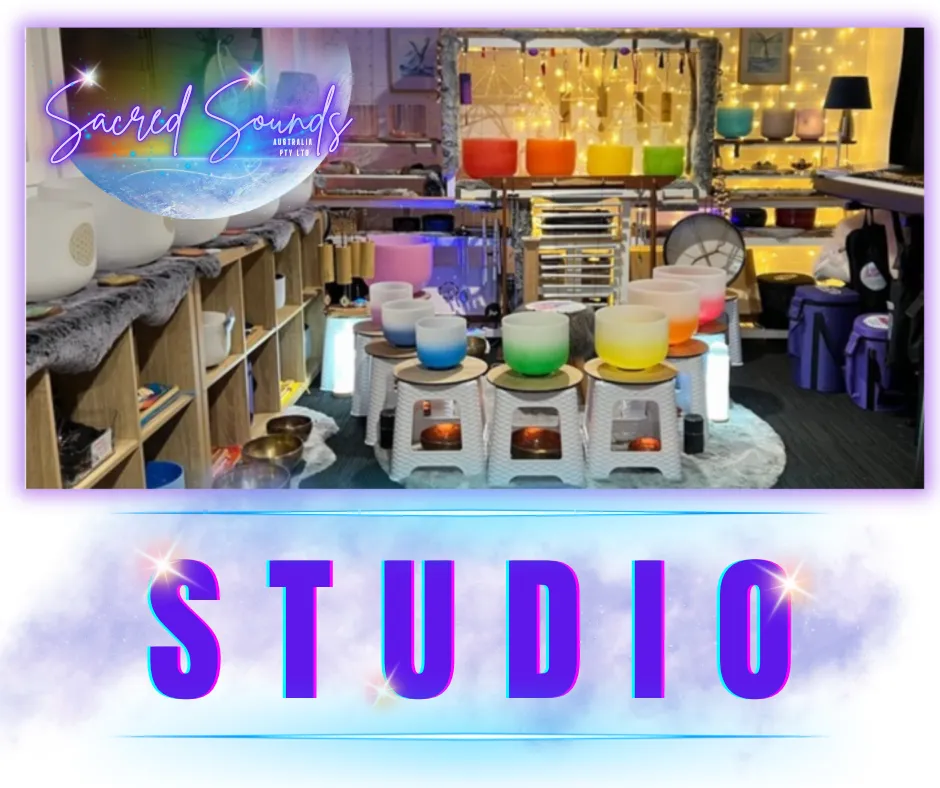
Sacred Sounds Studio
This is the home of all of our recordings, online sessions and our instrument collection. This space is a private home based studio and therefore can only be accessed online by appointment only. You can follow us on social media at the following space for more information and to book on a group event or for your own private session. For more information visit
✅ in-Person ✅ Online ✅ Private ✅ Group ✅ Bookings Essential (See Link Below)
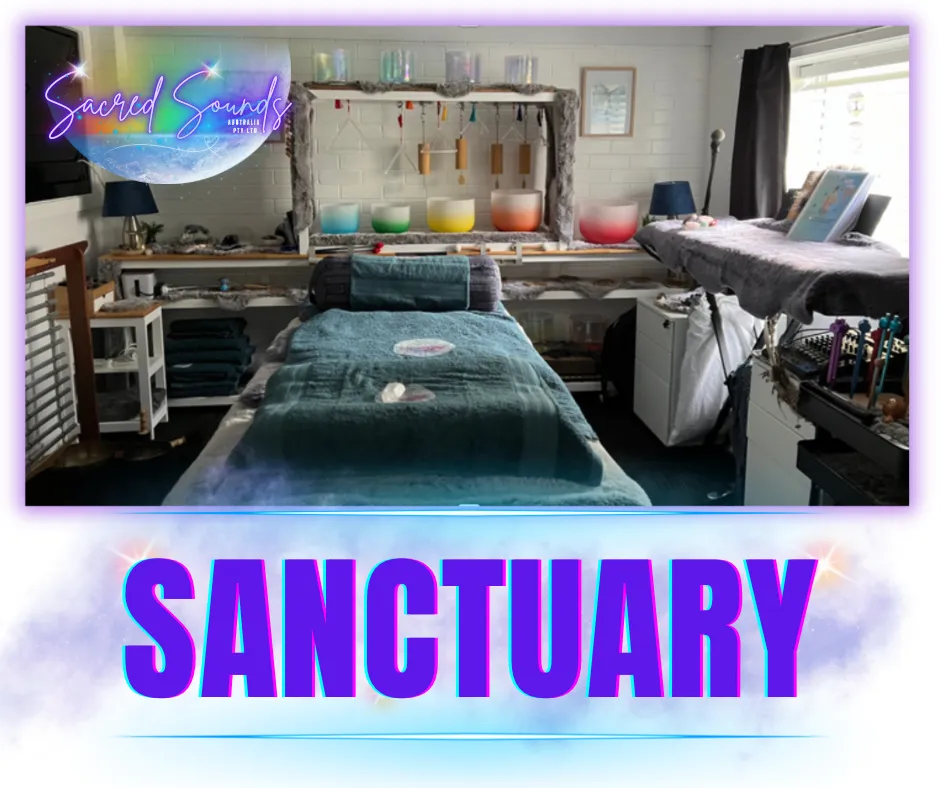
Sacred Sounds Sanctuary
This is the home of our ‘Sacred Sounds Journeys’ these therapeutic sessions can be booked in-person or online and we have our entire Sound Instruments available to ensure that you can enjoy the tranquility and serenity of a fully immersive sacred sound experience for the ultimate results during your session. You can book your sessions online via Humanitix just follow this link to make a booking. For more information visit
✅ in-Person ✅ Online ✅ Private ✅ Group ✅ Bookings Essential (See Link Below)
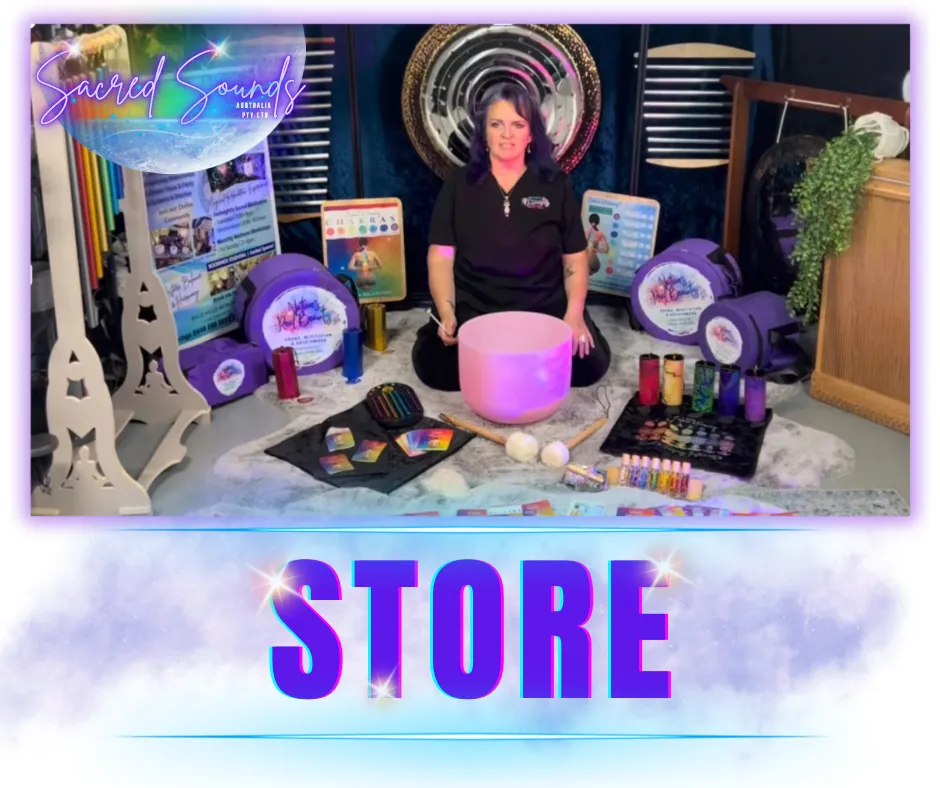
Sacred Sounds Store
This is the home of our ‘ Sacred Sounds Store ’ you can book an in-person or online private viewing for FREE in 30 or 60 minute time increments to discuss all of your Sound Therapy Instrument requirements. You can also browse our catalogue via email or online. There is so much to choose from and we have a vast knowledge and credible suppliers that can support your decision to invest in your own collection of sound Instruments. We offer ‘Sound’ advice from a 1-on-1 and group soundbath perspective for beginners and seasoned practitioners. We can help take the guesswork out of the industry that is bombarded by many companies just pitching for sales. We CARE about your commitment to bringing sound and vibrations to your audience whether that is just for you, your family, your clients or your community. We can offer personalised quotes and sound ideas to match your intended use. For more information visit our online store or book a visit below
—————————————————————————————-
Open Hours: Book an In-Person or Virtual Browse
Wednesday 8am-6pm | Thursday 12pm-8pm | Friday 8am-6pm
Saturdays 10-4pm | Sundays 2-6pm
By Appointment ONLY
Email: [email protected]
Call: 0448 280 580
—————————————————————————————-
✅ in-Person ✅ Online ✅ Private ✅ Group ✅ Bookings Essential (See Link Below)
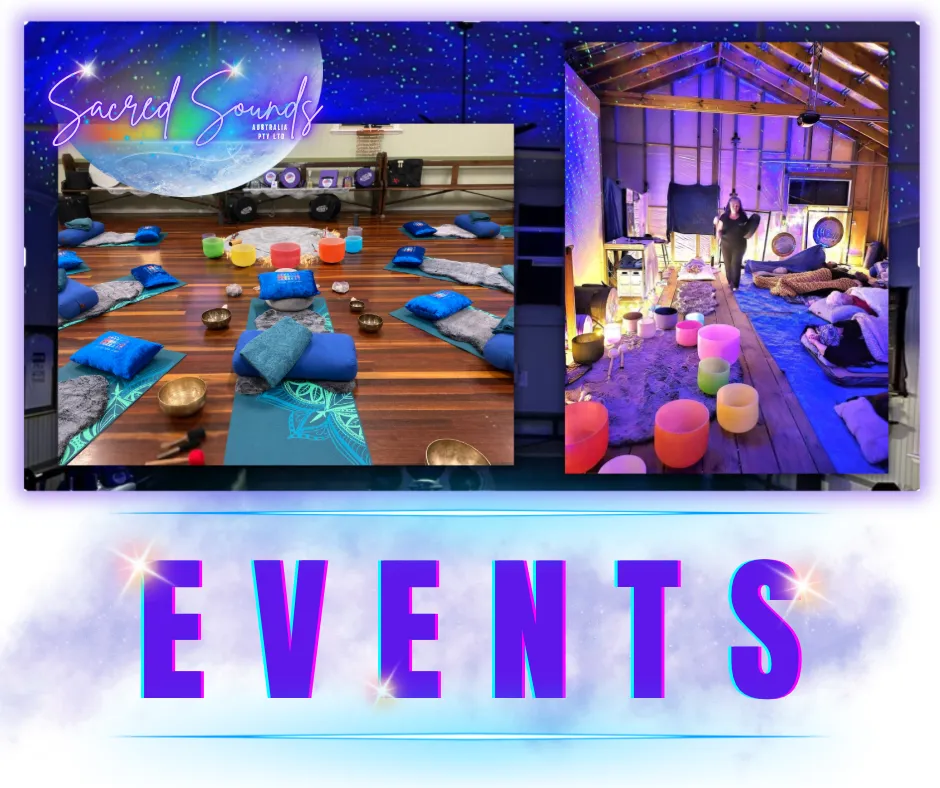
Sacred Sounds ‘Soundbath’ Events
This is the home of our ‘ Sacred Sounds Soundbath Events ’ you can book your front row seat, and take advantage of our early bird prices. Join a community of like minded people that gather on a regular basis to restore harmony and balance in our fully immersive sacred sounds guided meditation and sound journey experiences. We offer, intuitive, guided community Soundbaths and offer activations, atunements, mediumship and sound readings ag our events.
✅ Moon Ceremony Sound Journeys ✅ Sacred Souls Discovery Journeys ✅ Astrology Sound Journeys
✅ Relaxation Sound Journeys ✅ Chakra Balancing Sound Journeys ✅ Cosmic Event Sound Journeys
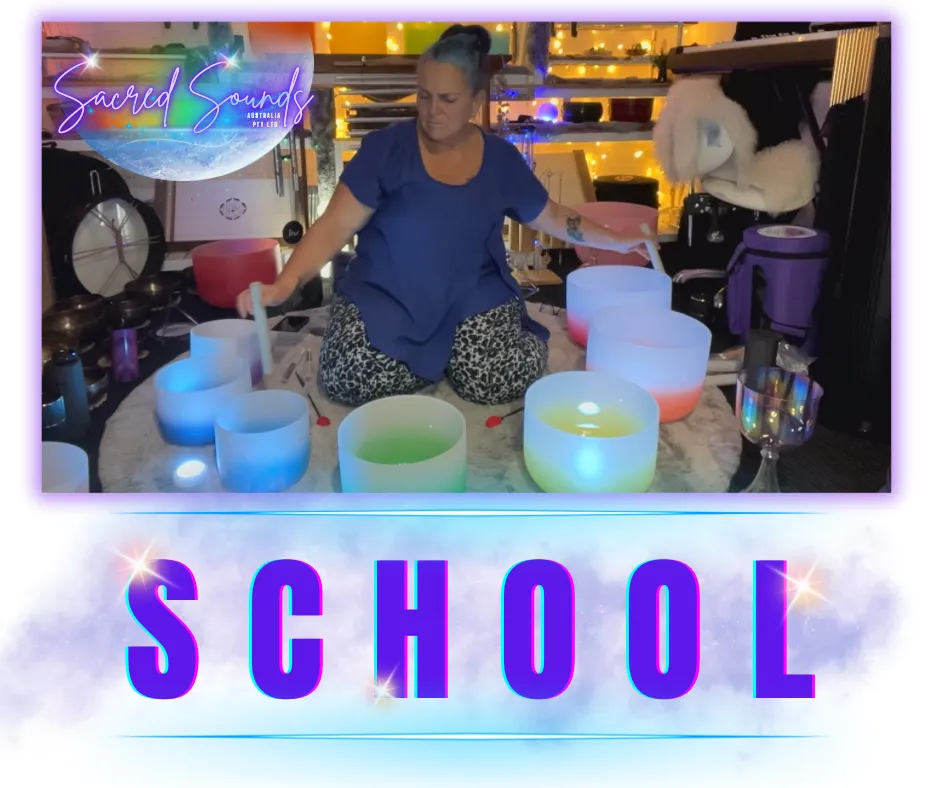
Sacred Sounds School
This is the home of our ‘ Sacred Sounds School ’ you can book an in-person or online private or group instrument workshop. We have got you covered from the beginning of your Sound Journey to infinite possibilities. From the investment in your first instrument we have learning and support
solutions for you. We offer:
✅ Private Atunements ✅ Group Classes
✅ Private Lessons ✅ Levelled Workshops ✅ Click below for more info
Links are emailed when you enrol | Email us for more information
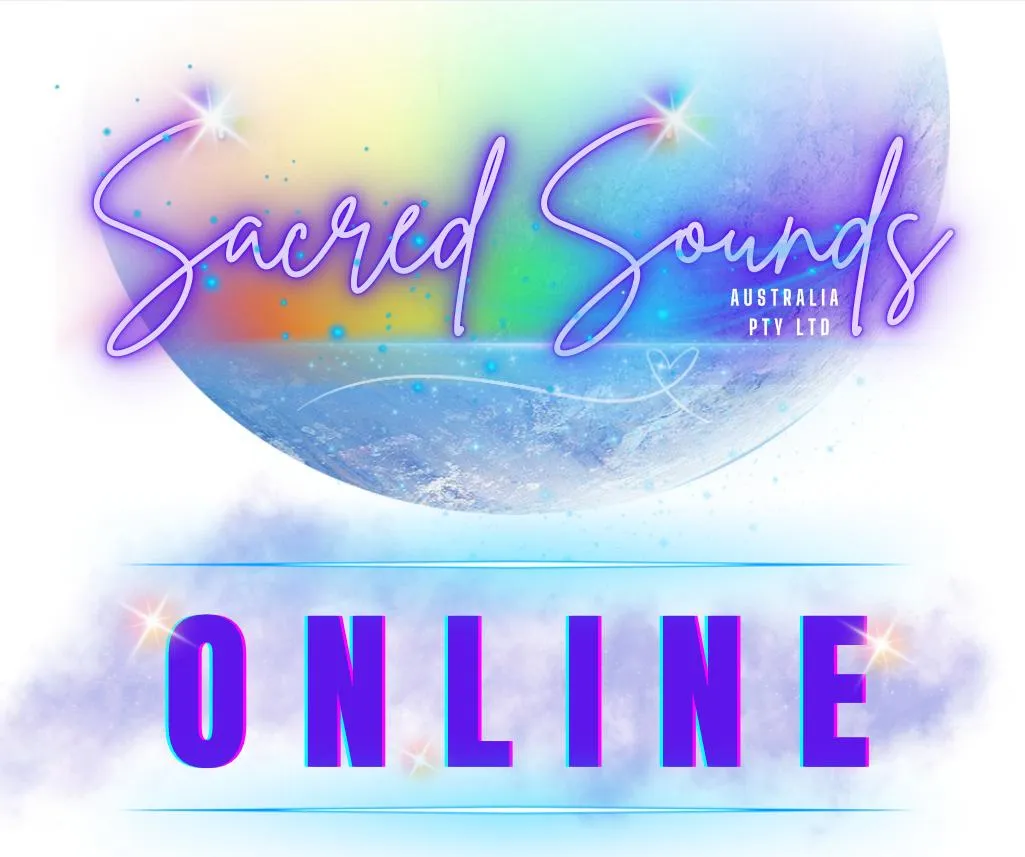
Sacred Sounds Online
There are many ways you can connect with us online below you will find links to all our online spaces
✅ Email Us @ [email protected]
✅ Facebook | Instagram | FB Community | Meetup
✅ Humanitix | Event Bookings
✅ Zoom | Online Events
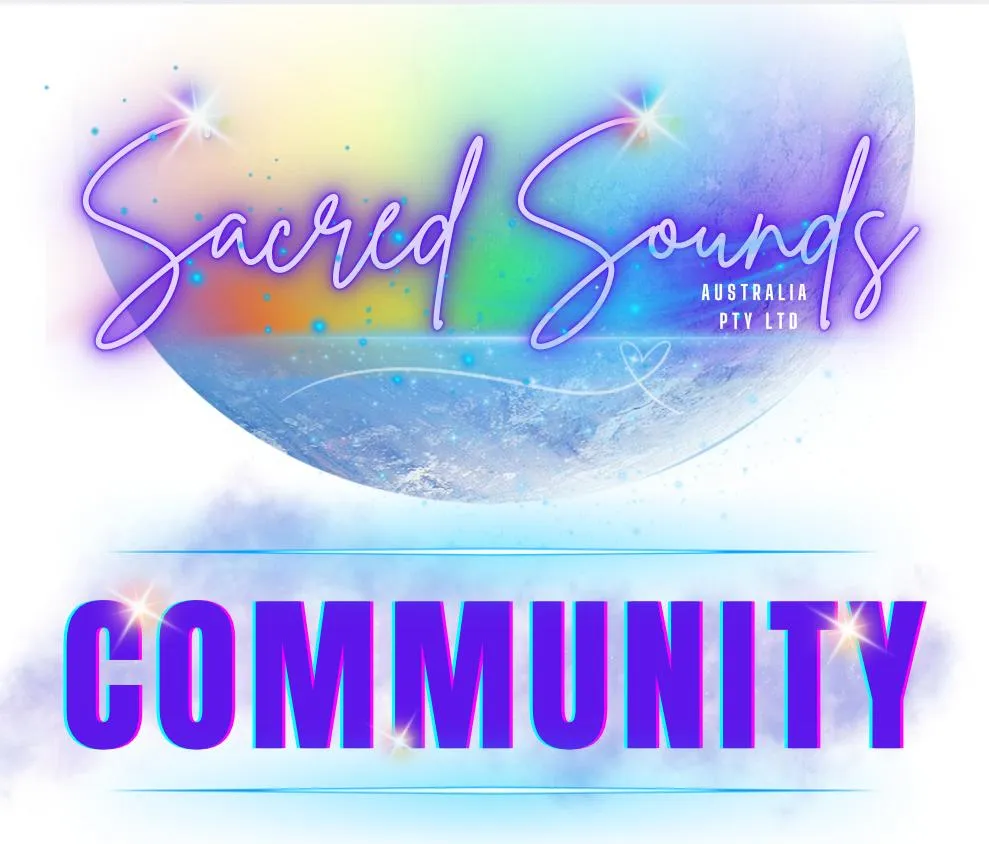
Sacred Sounds Community
This is the home of our ‘ Sacred Sounds School ’ you can book an in-person or online private or group instrument workshop. We have got you covered from the beginning of your Sound Journey to infinite possibilities. From the investment in your first instrument we have learning and support solutions for you. We offer:
✅ Subscribe to our Email ✅ Facebook Community ✅ Meetup Groups
Qualifications and Accreditation
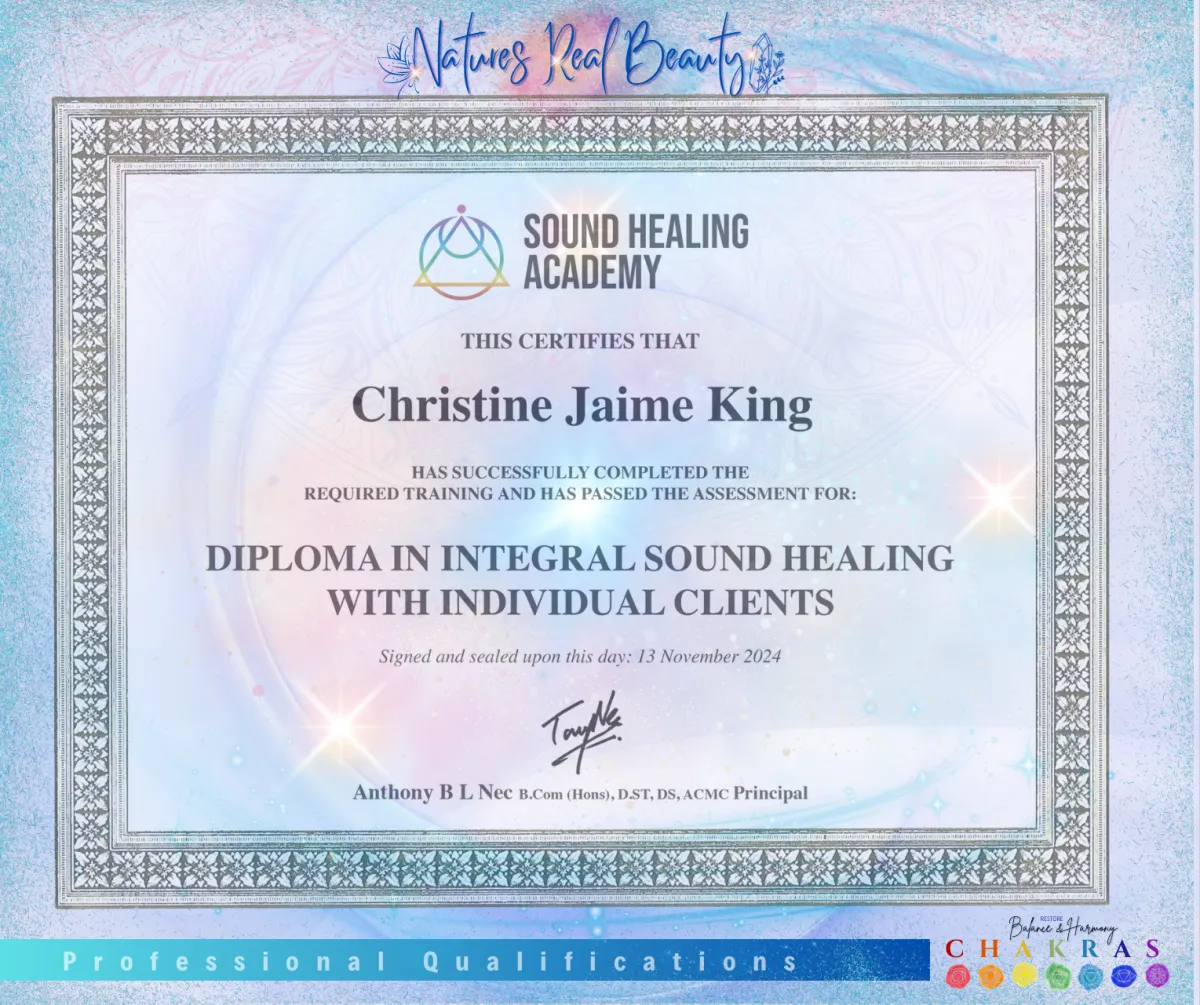
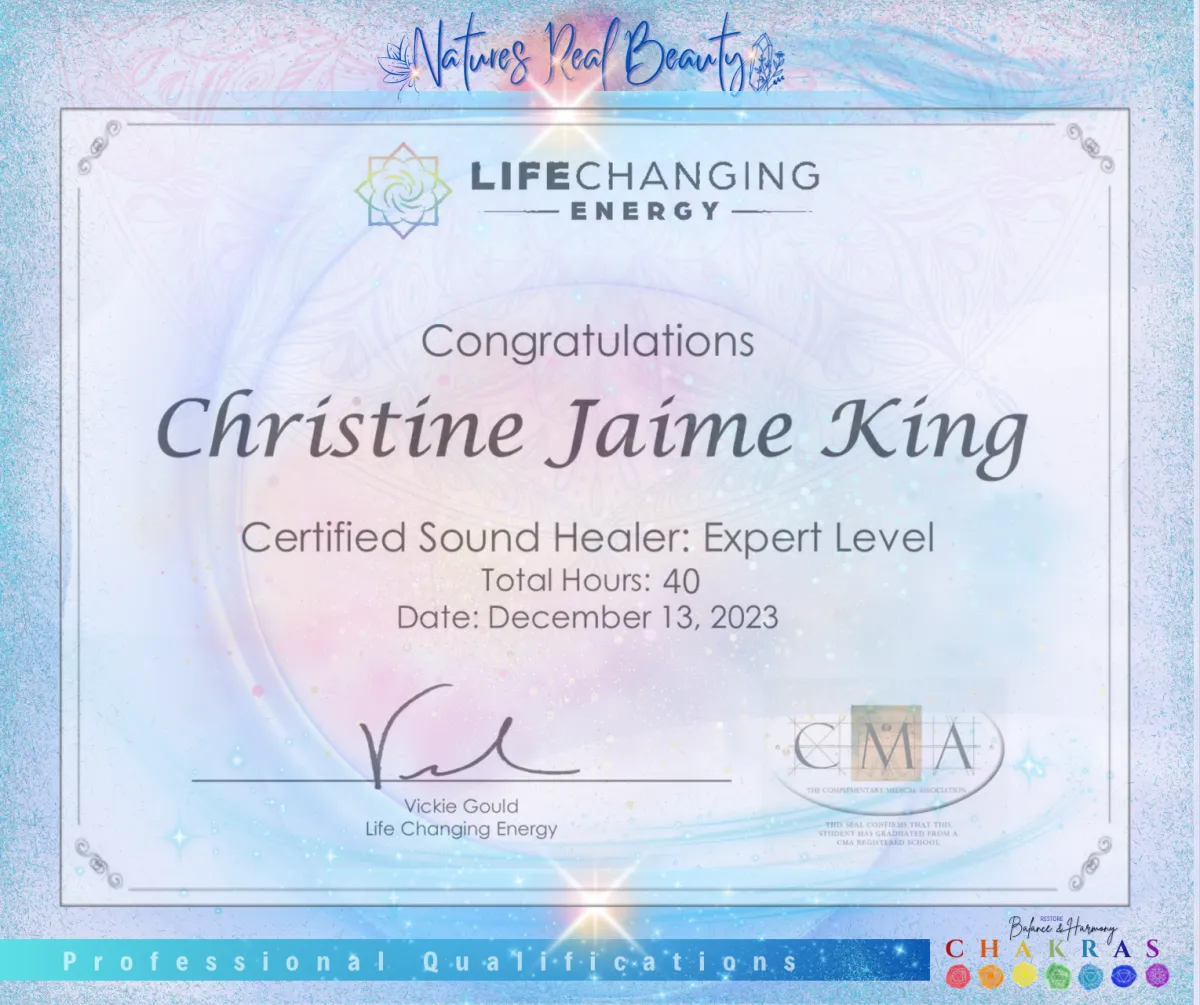
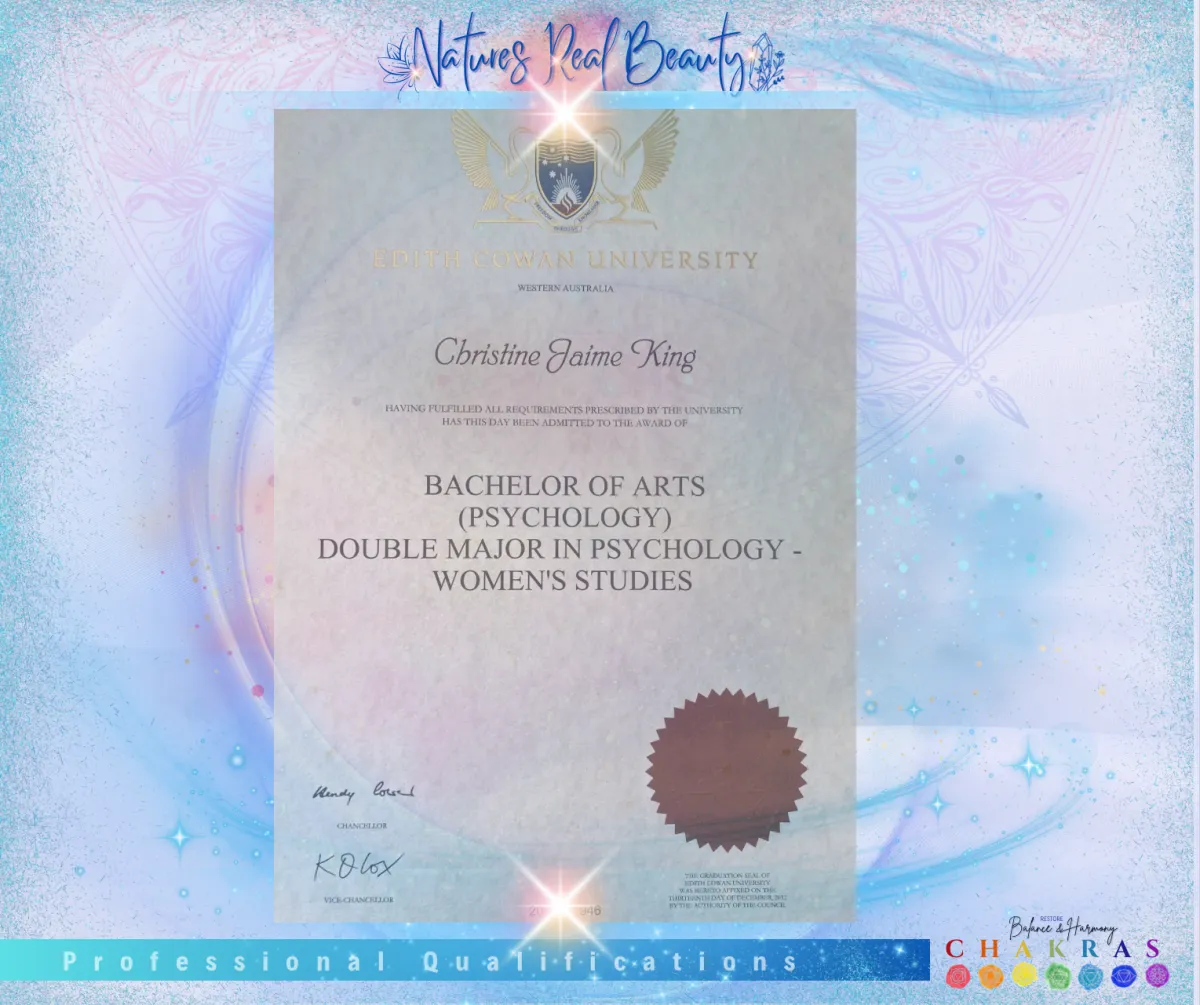
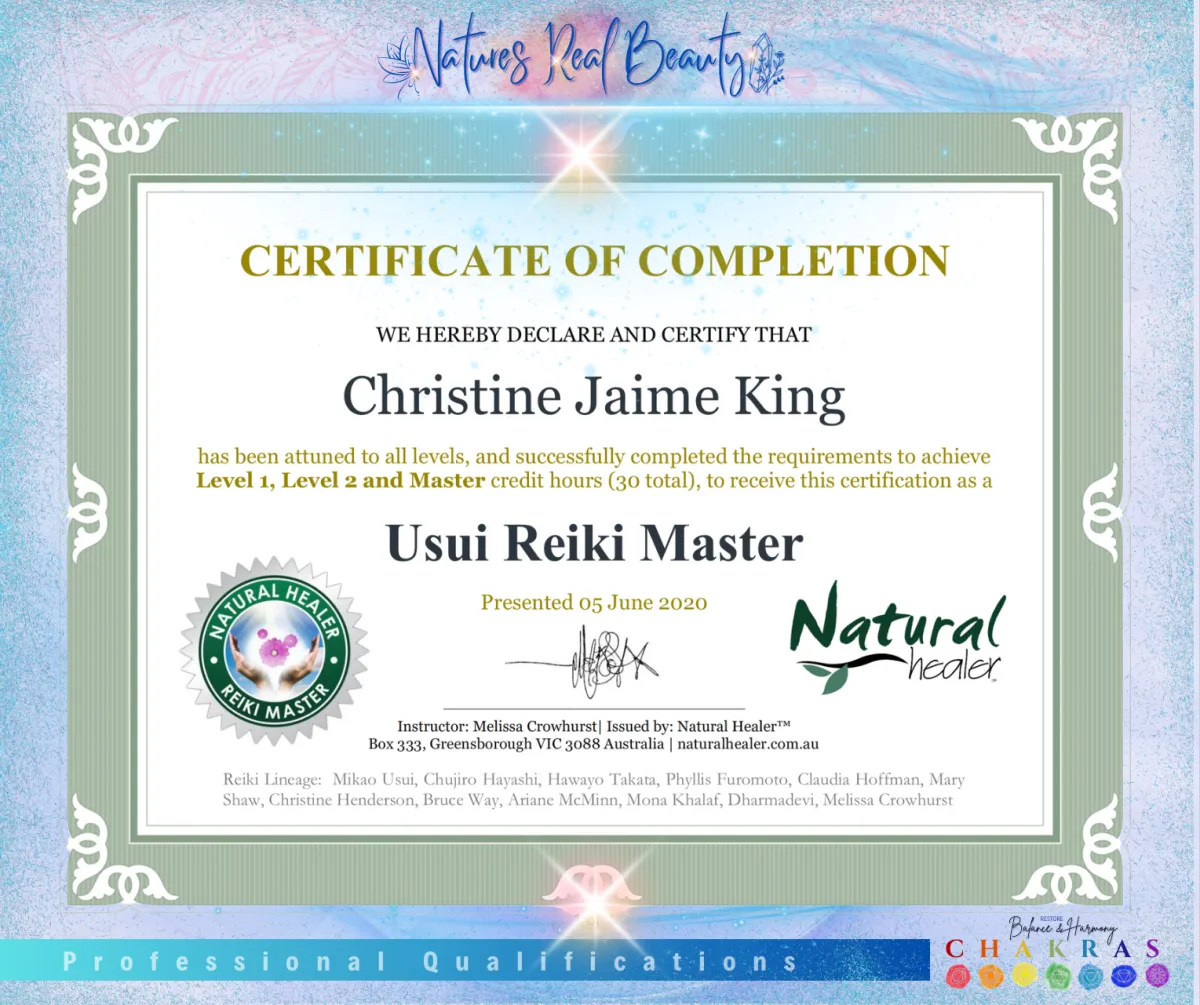
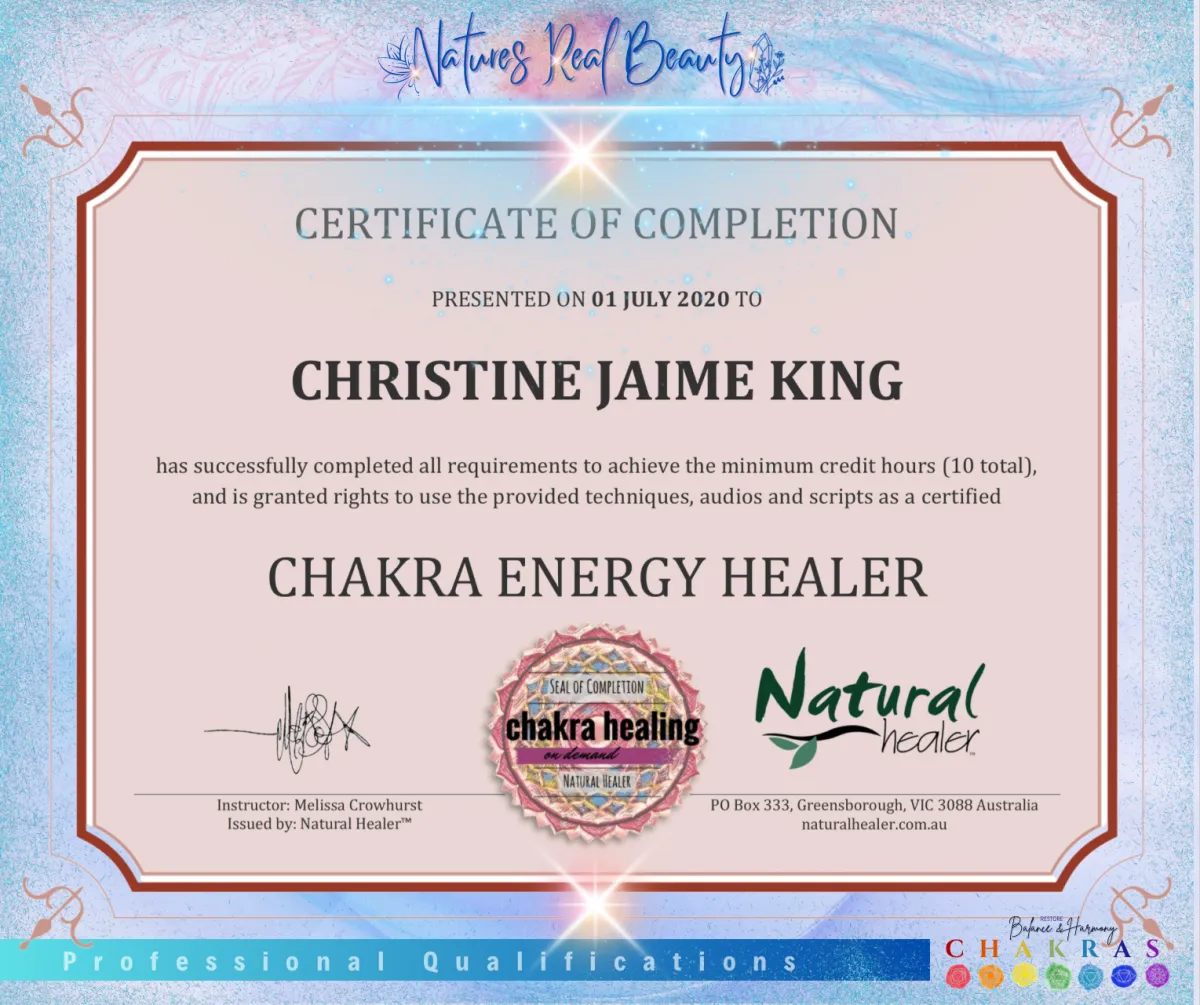

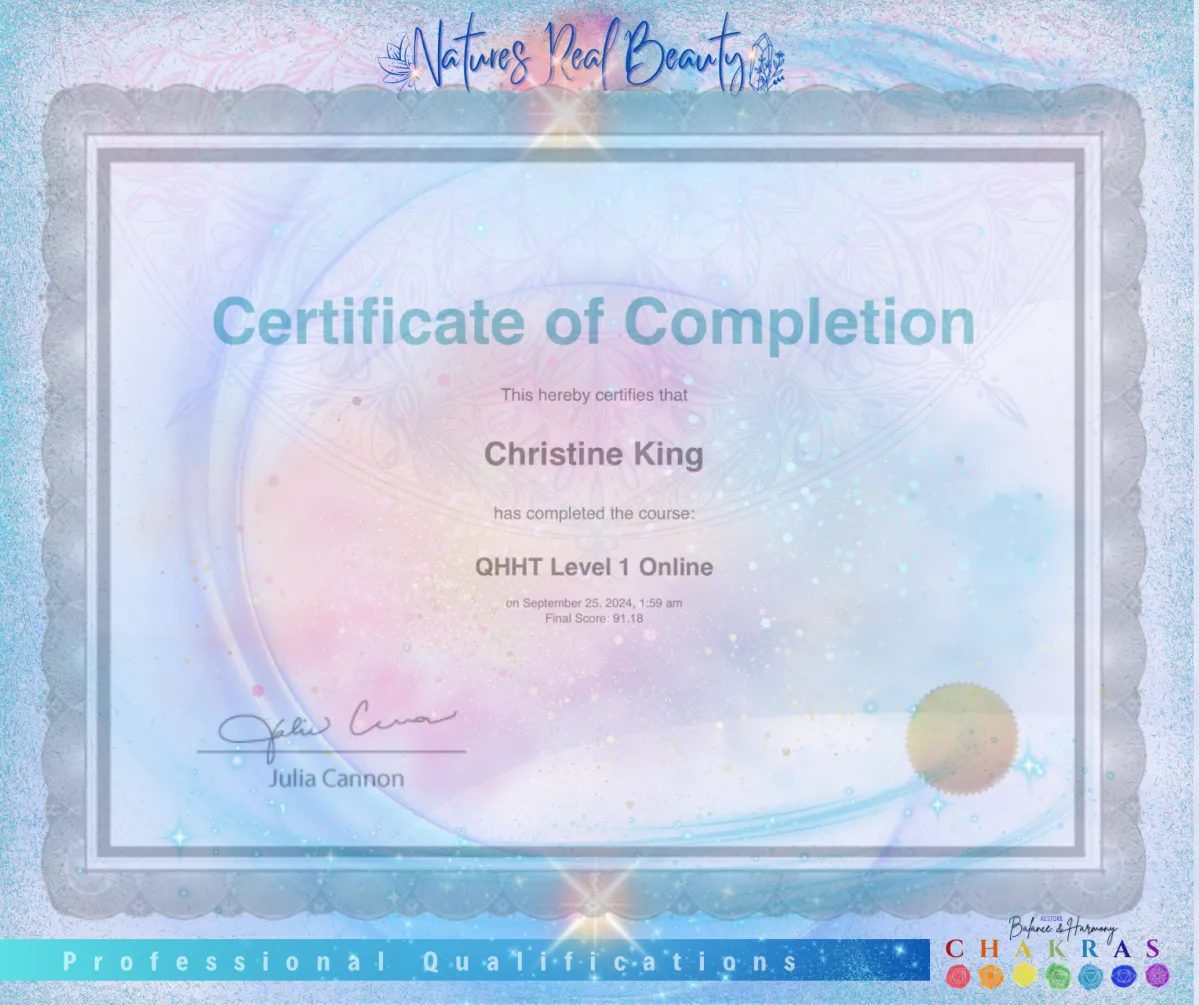
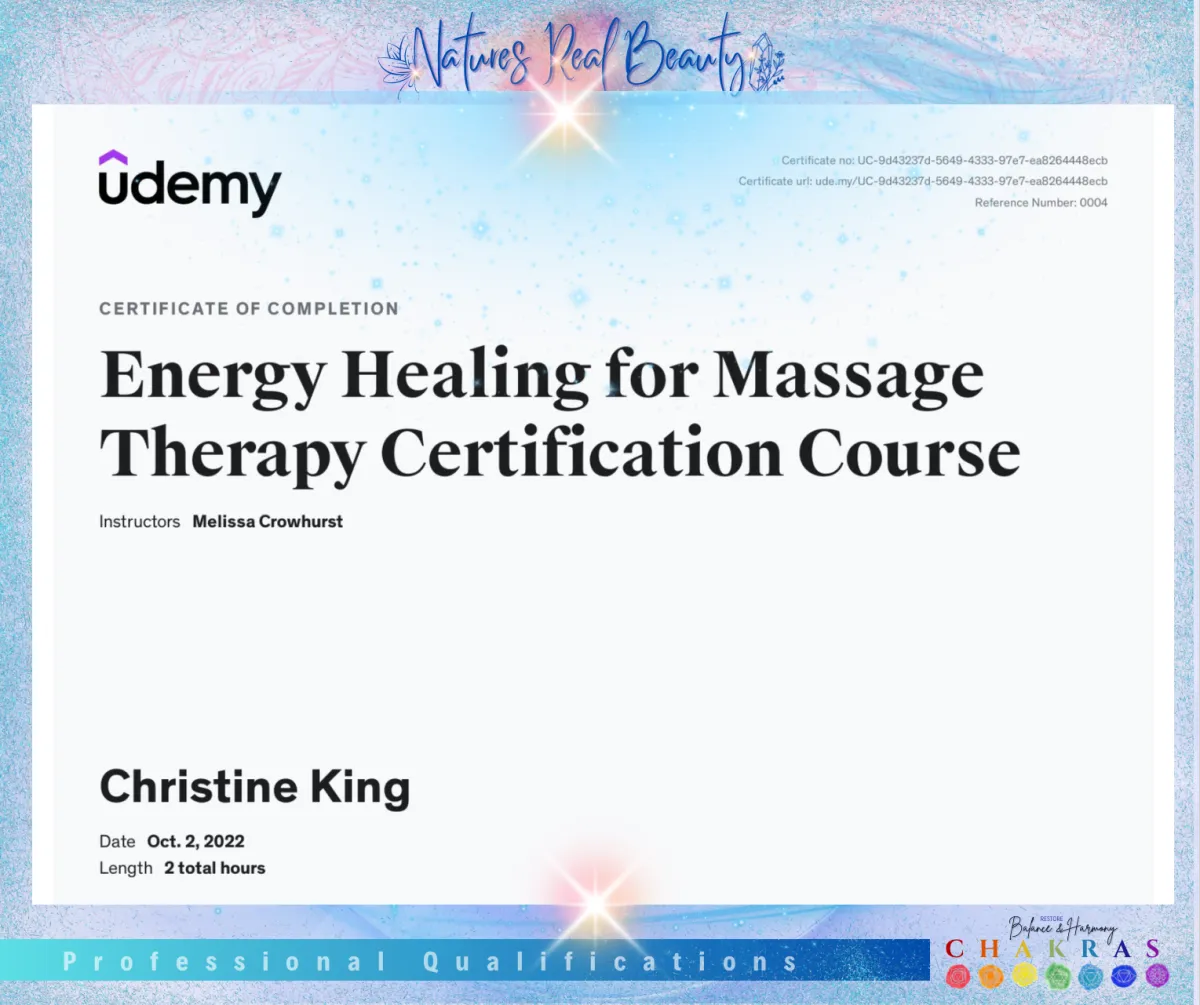
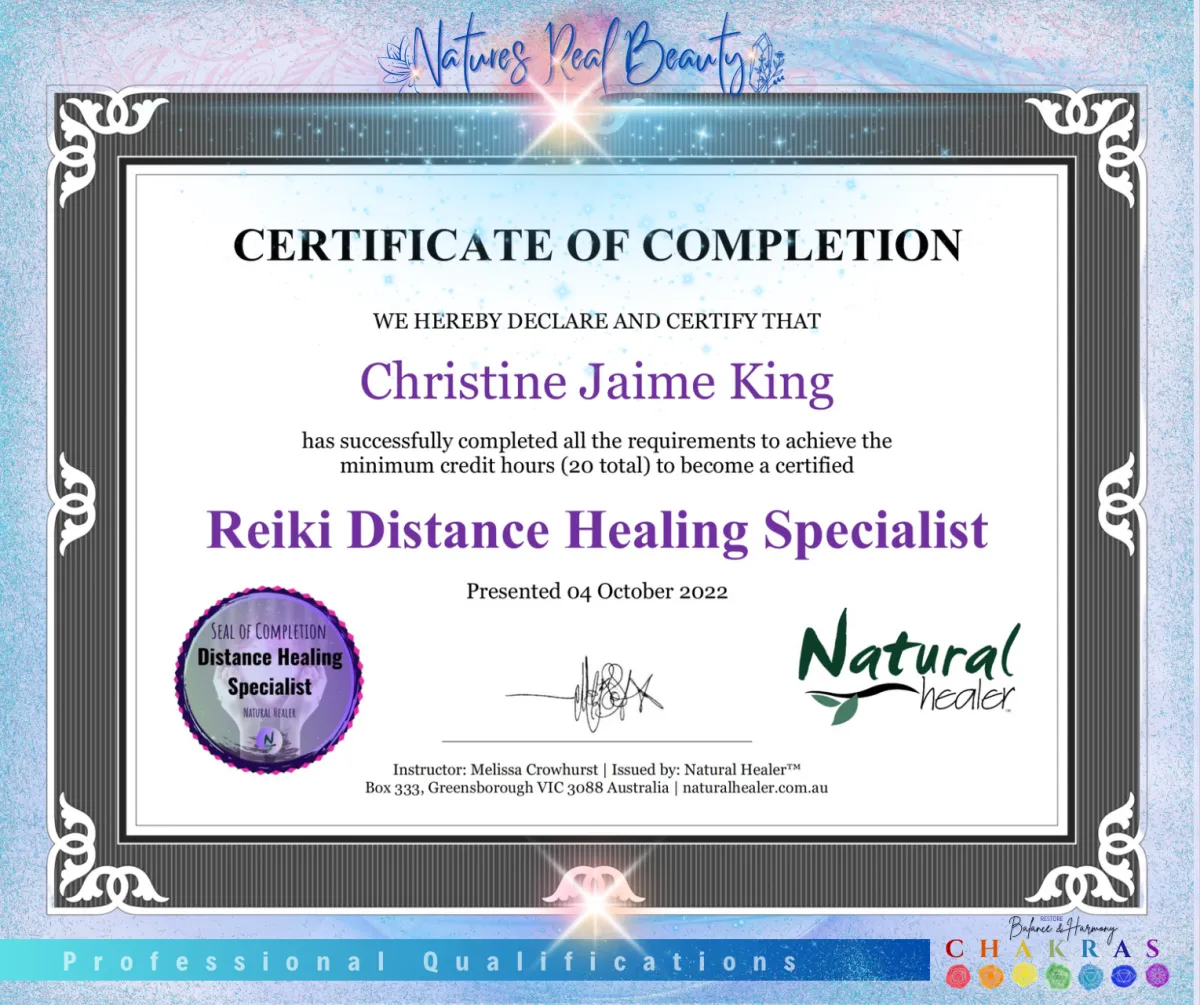
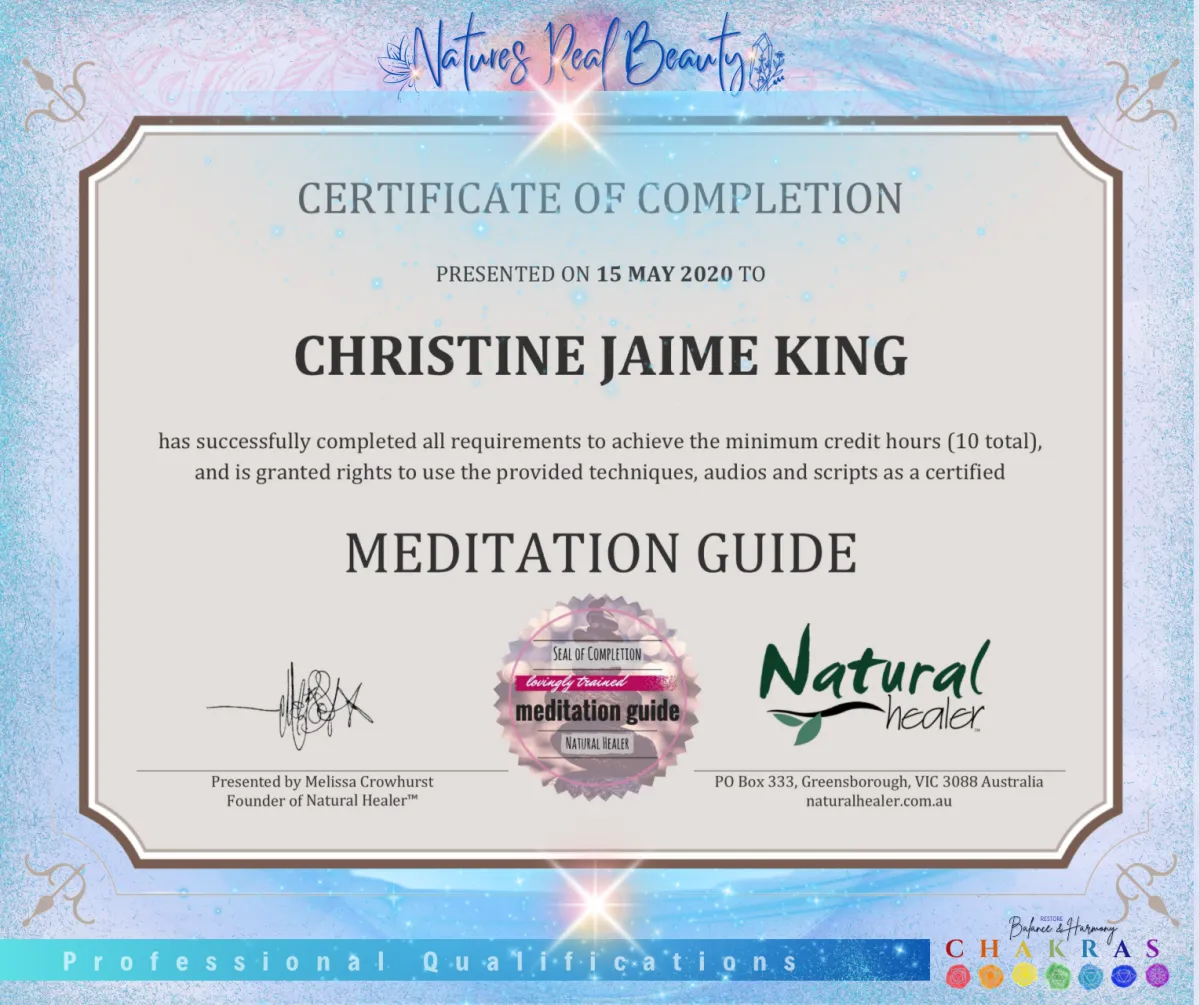
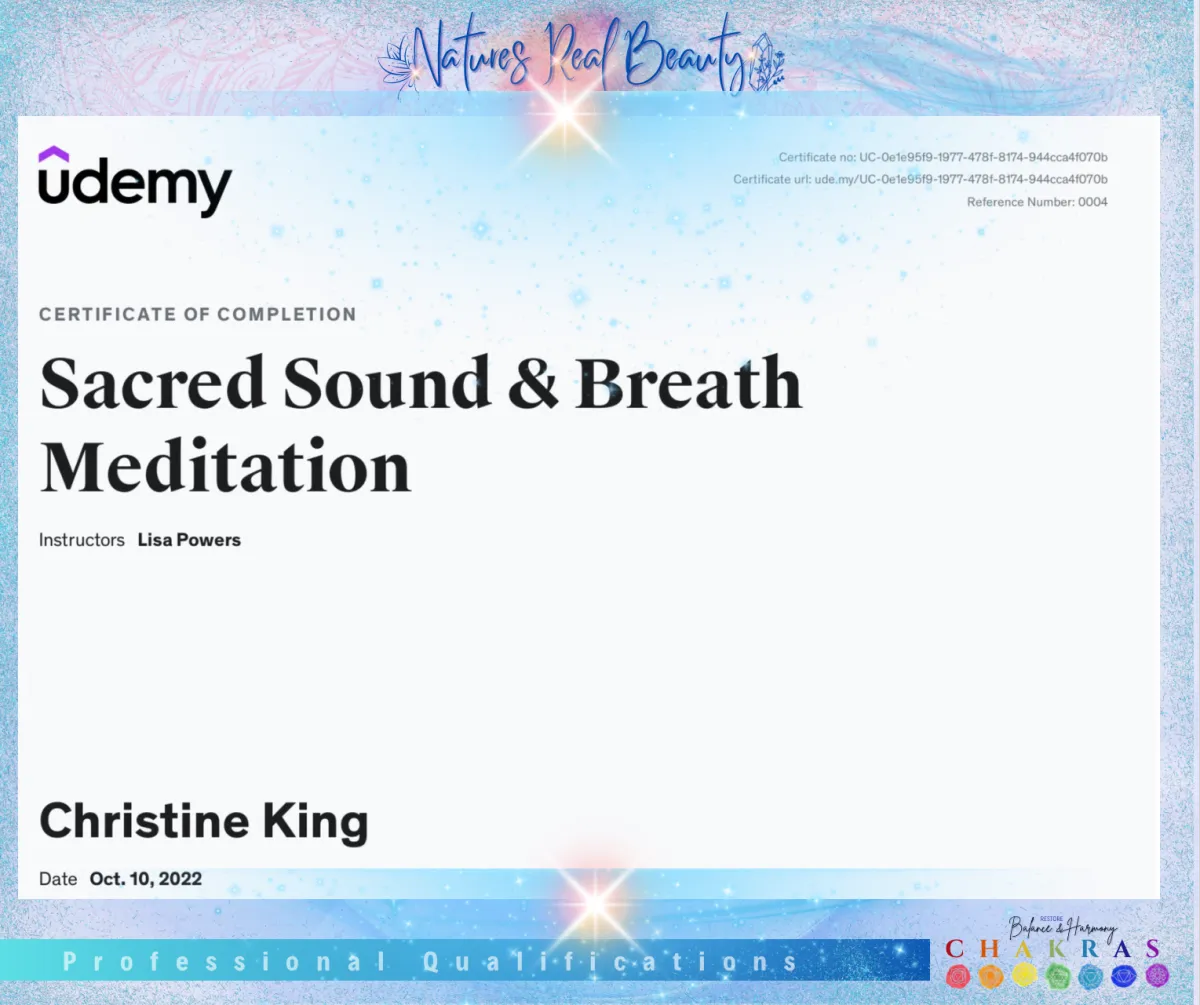
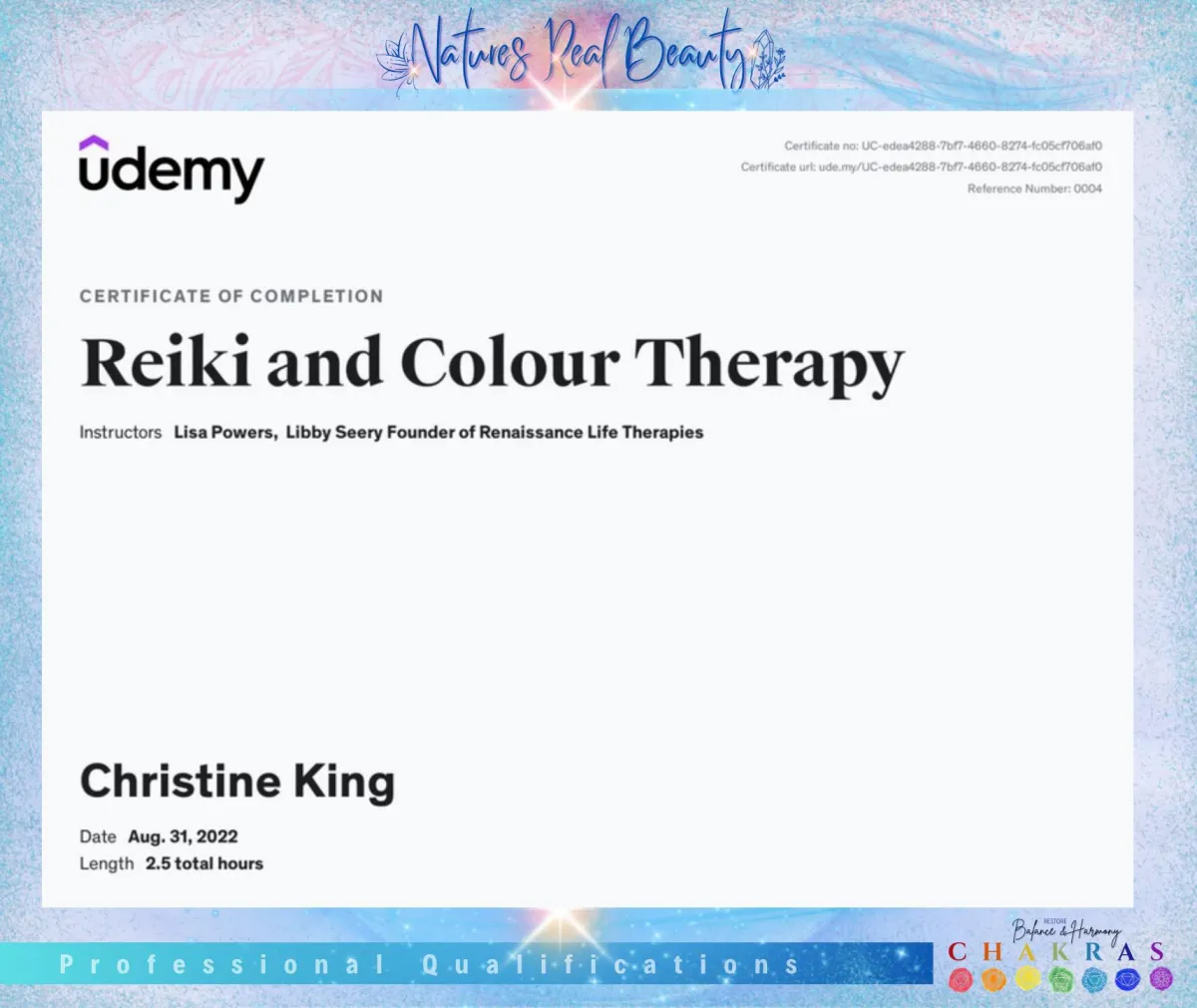
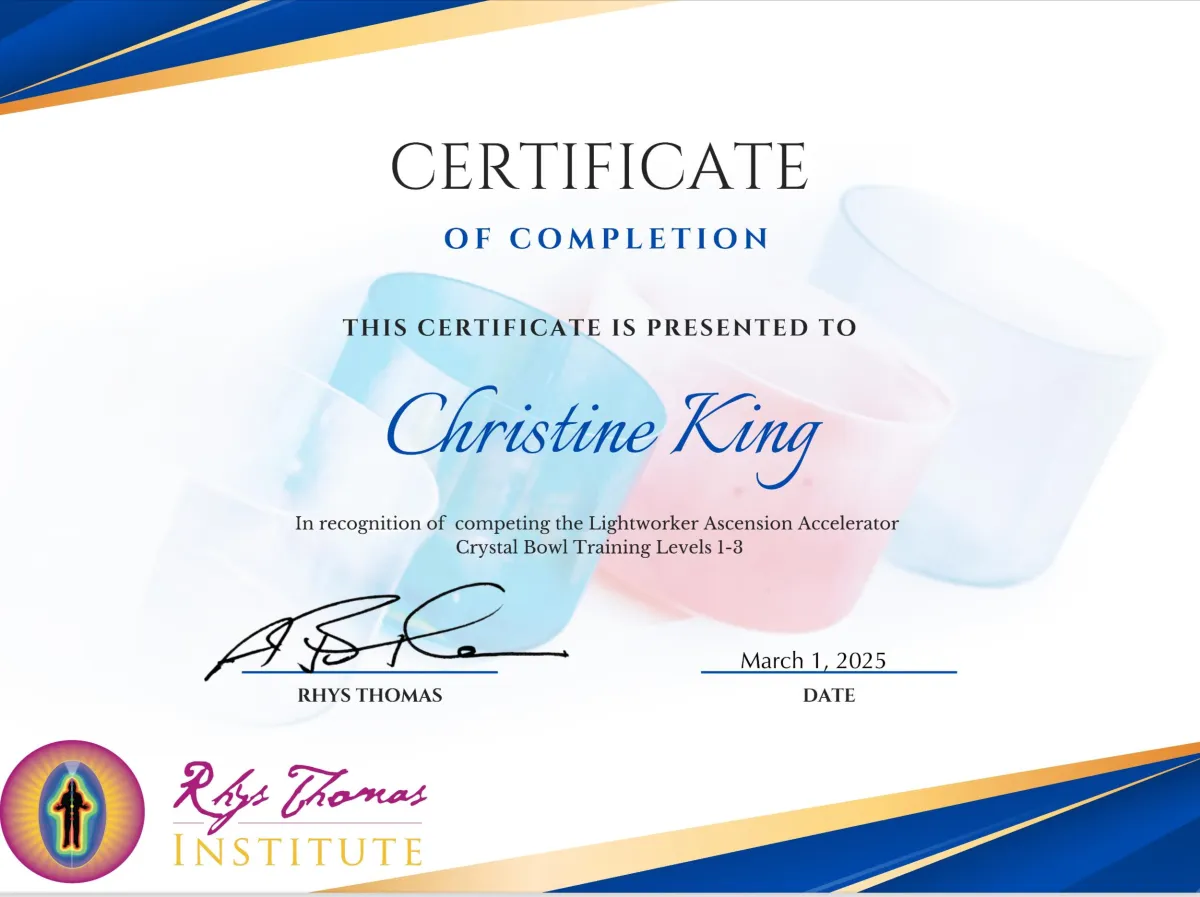
About Us
Brand your success with personalised promotional merchandise that captivates your audience.
Copyright© 2025 Sacred Sounds Australia - All Rights Reserved.
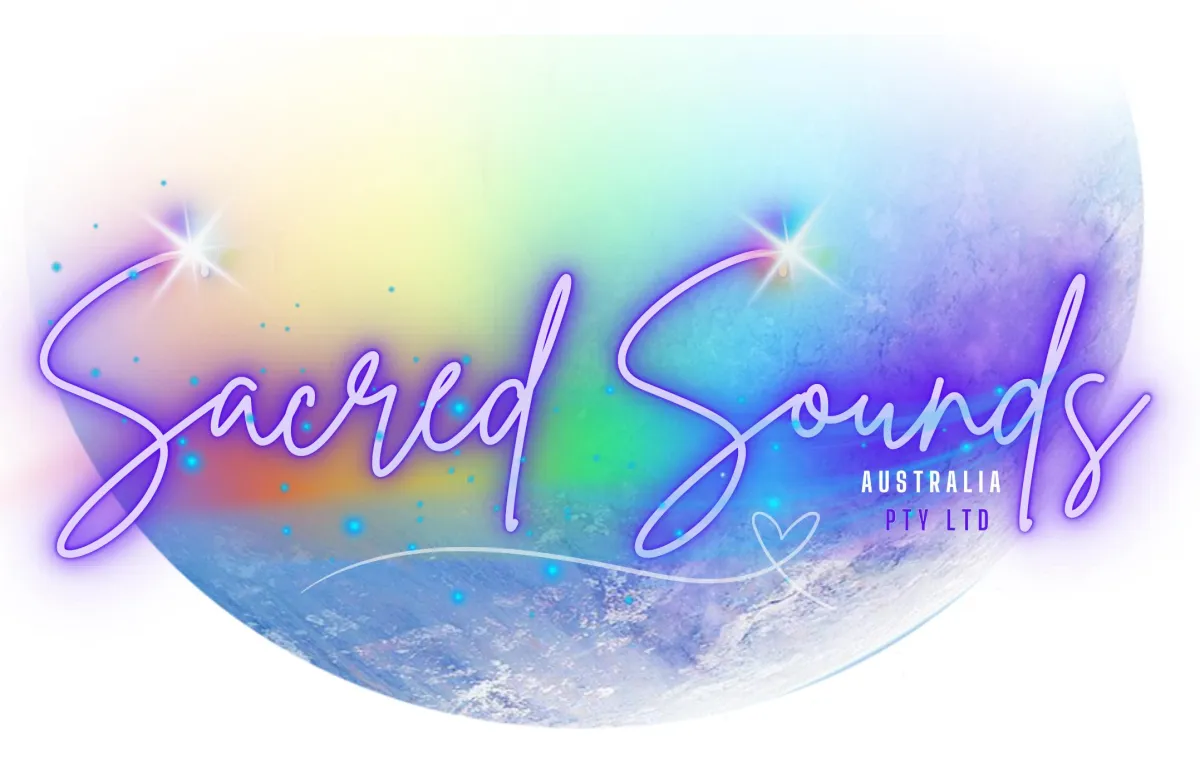
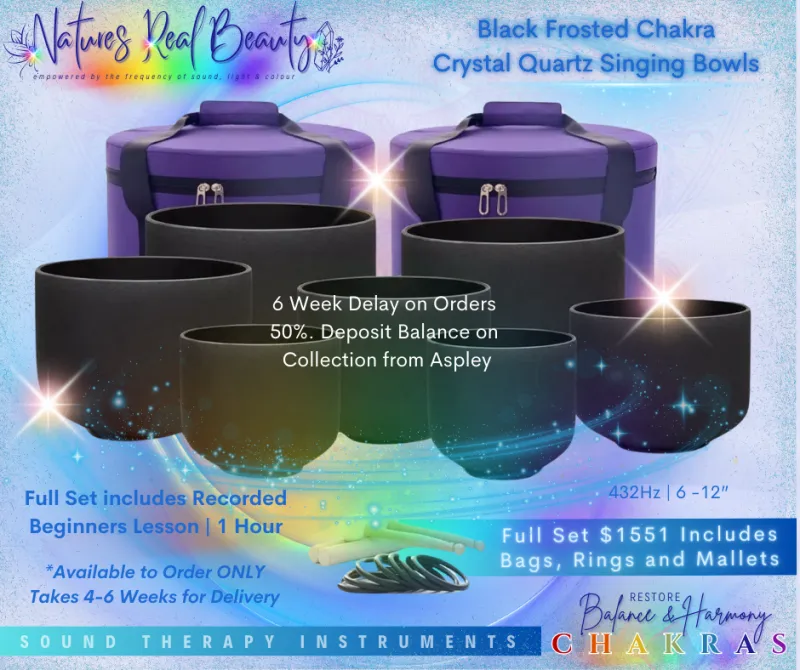

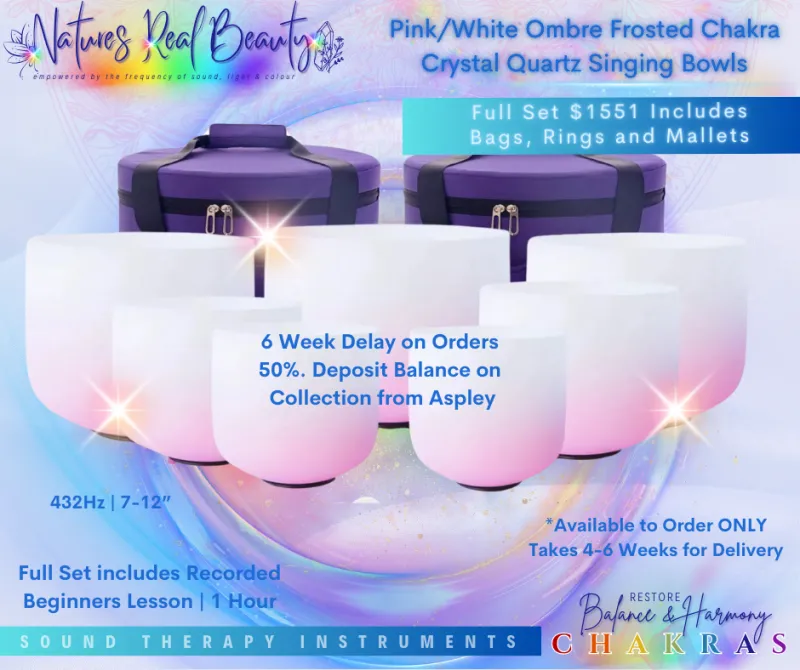

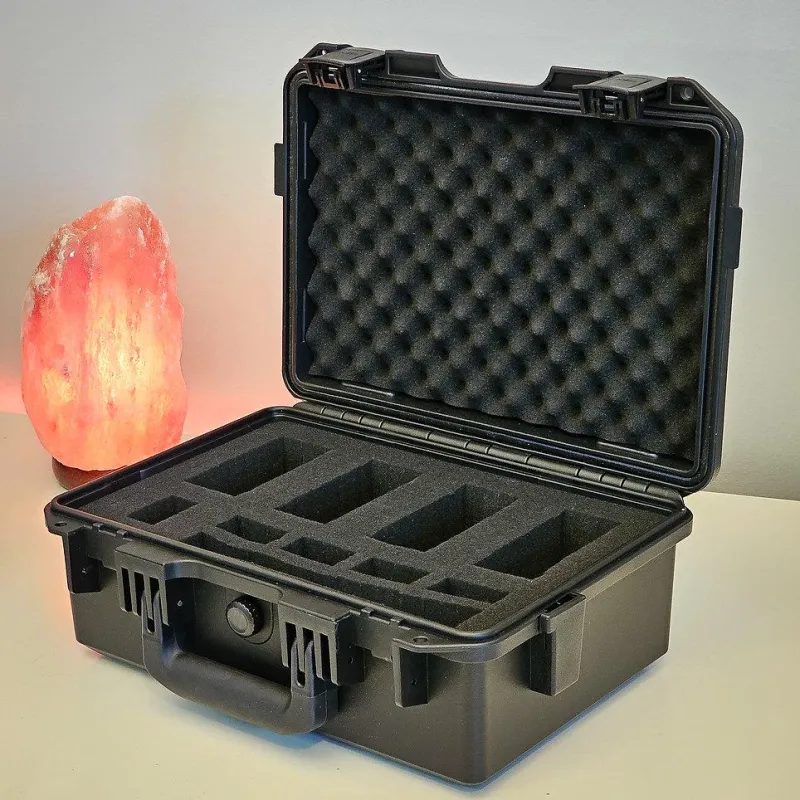
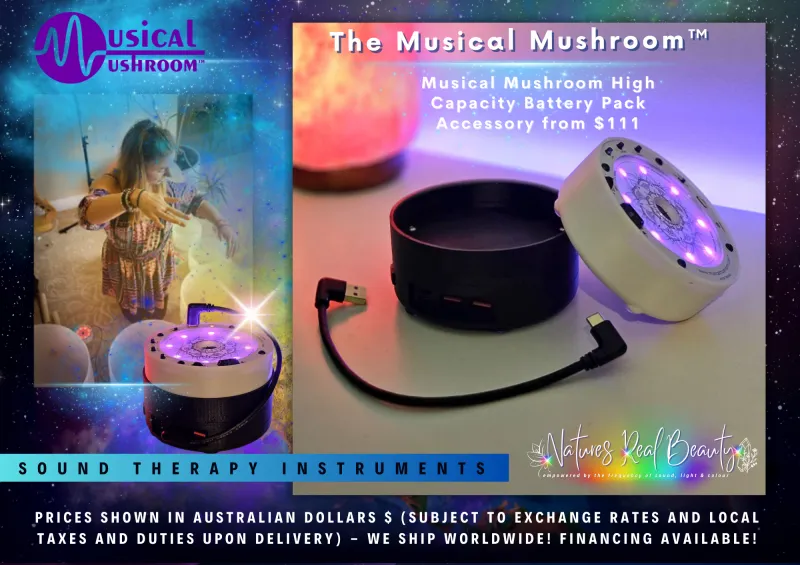

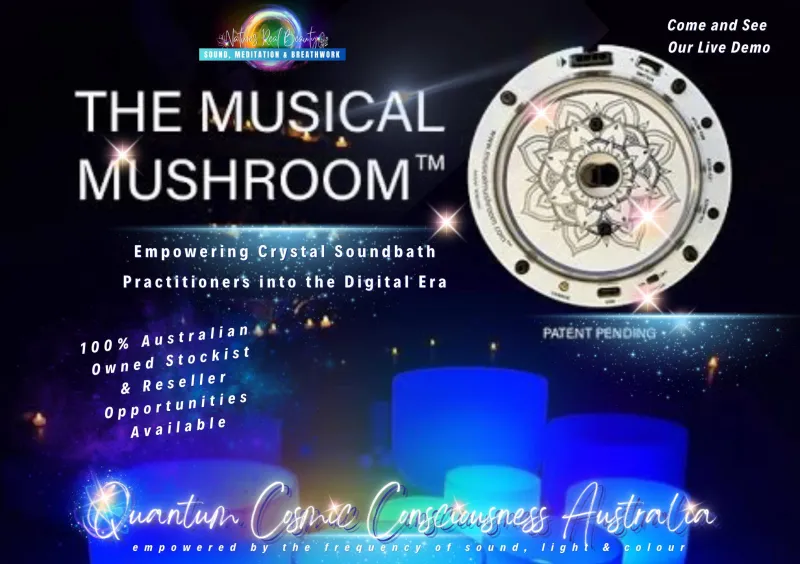



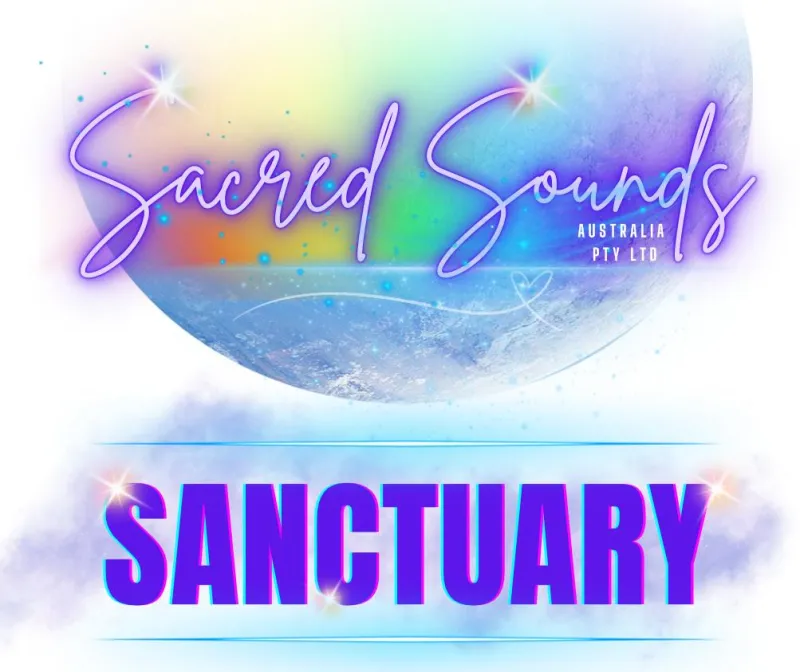
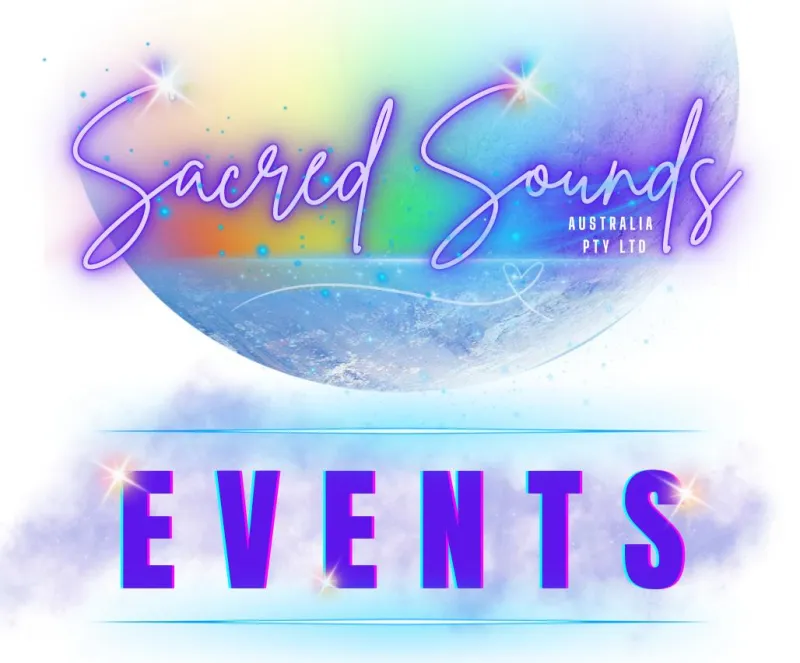
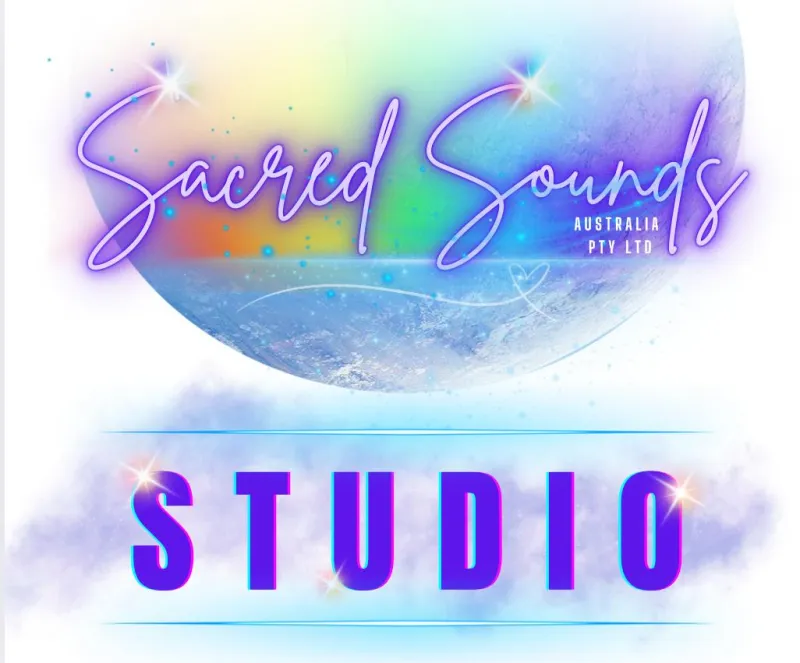
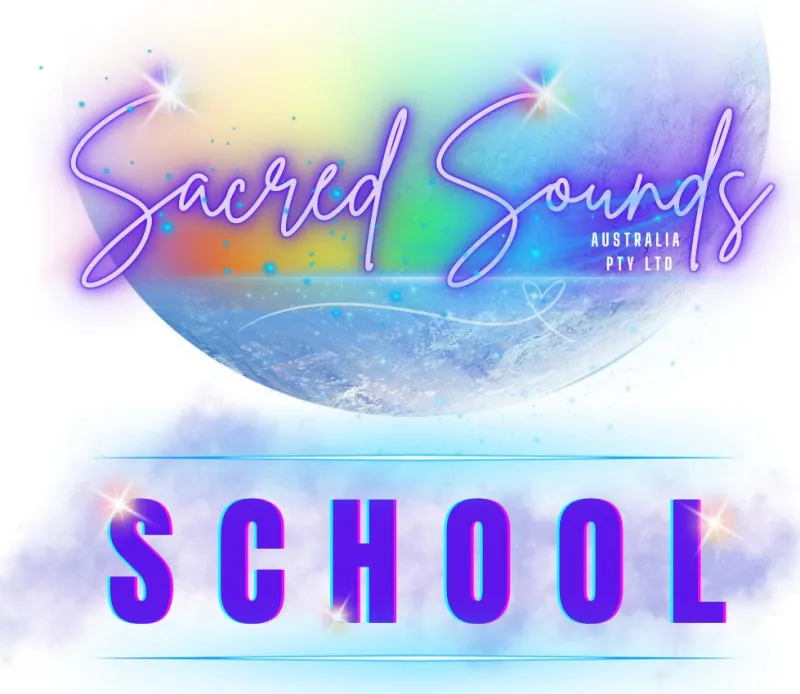



Facebook
Instagram
Website
Youtube
Mail